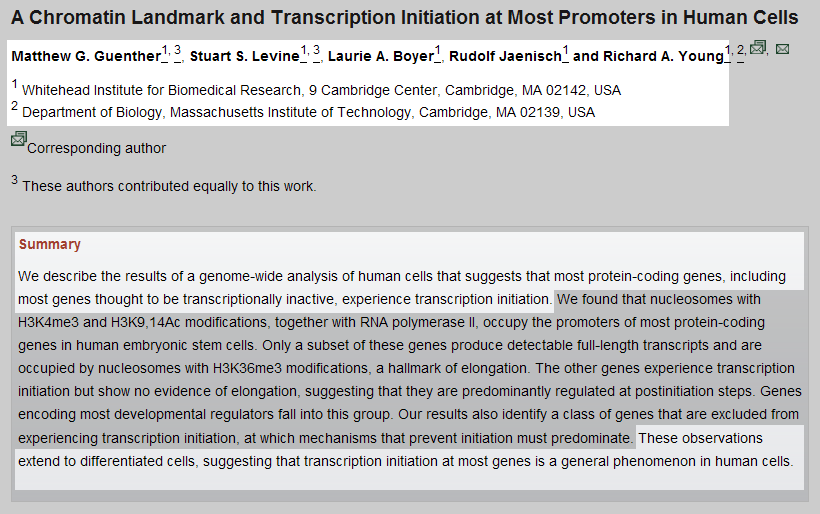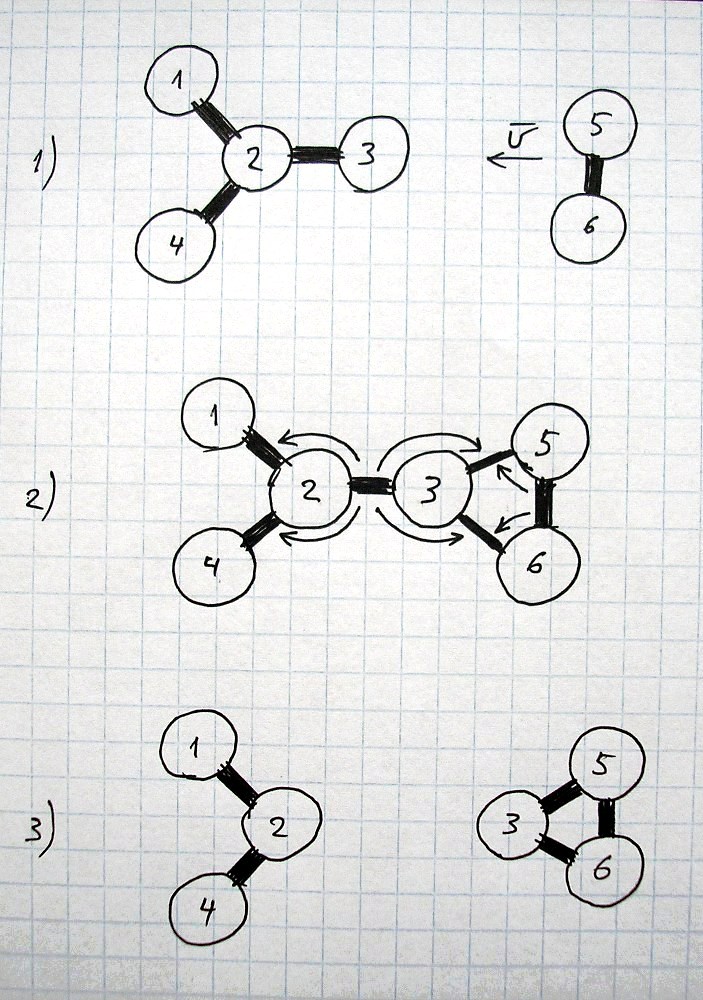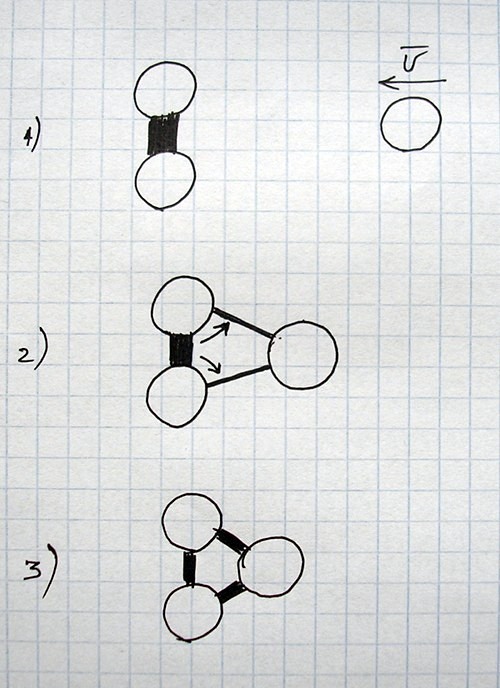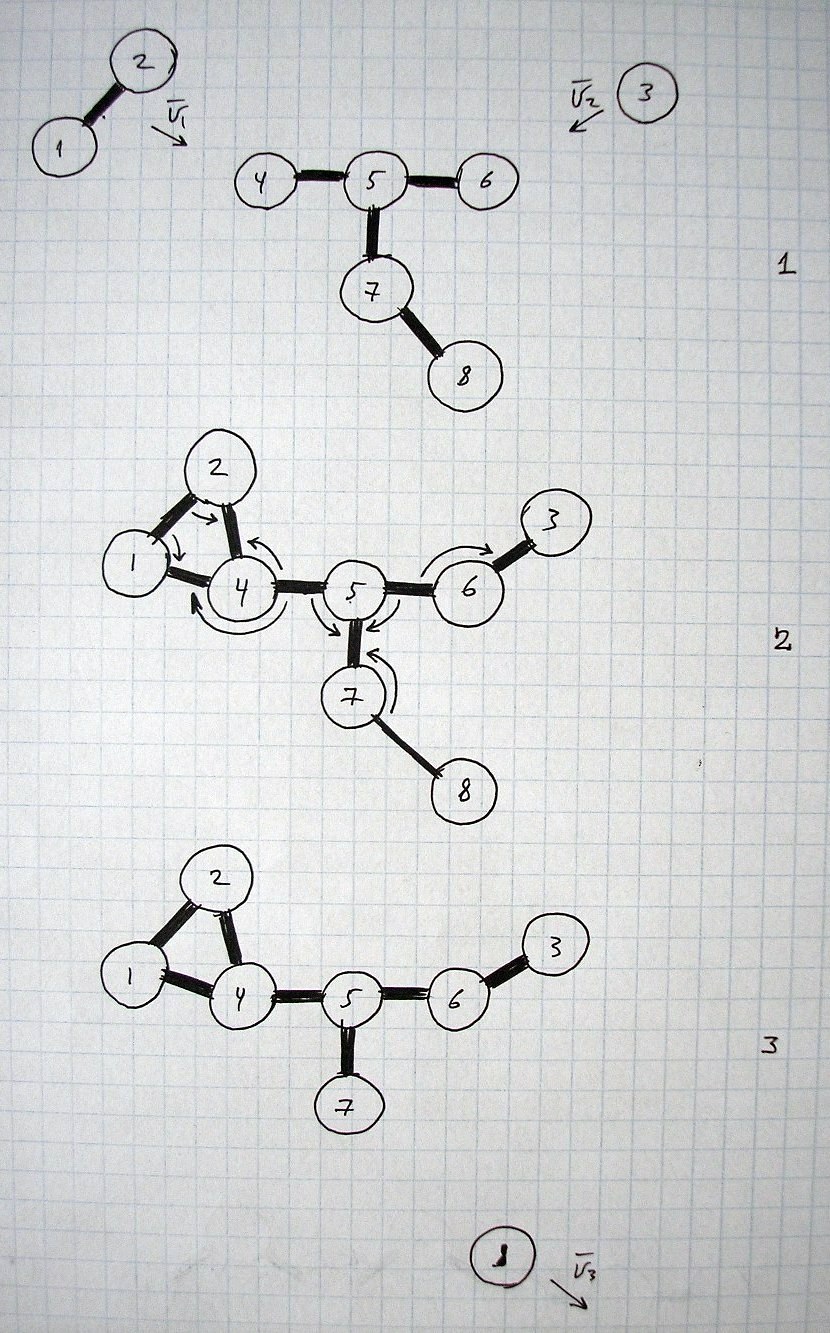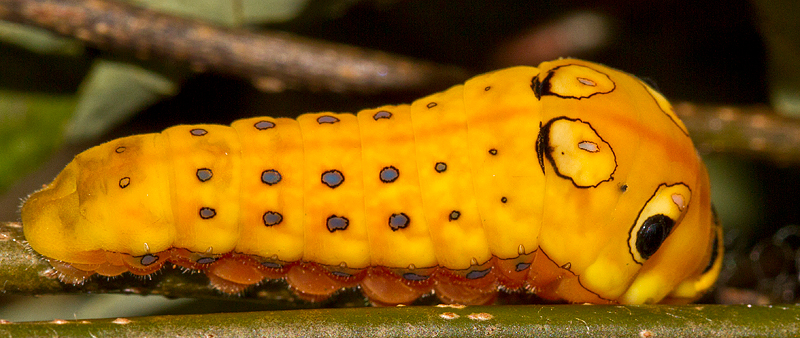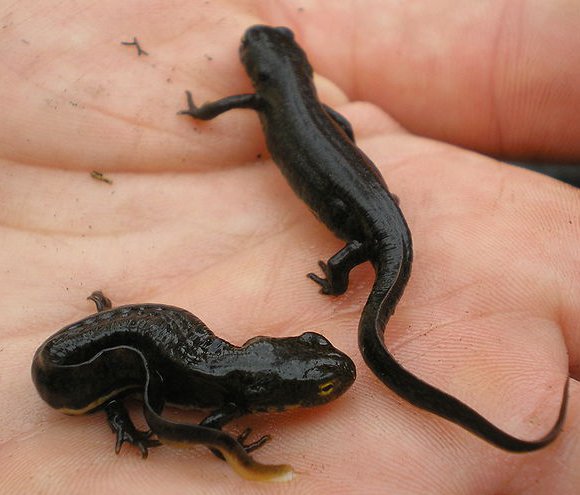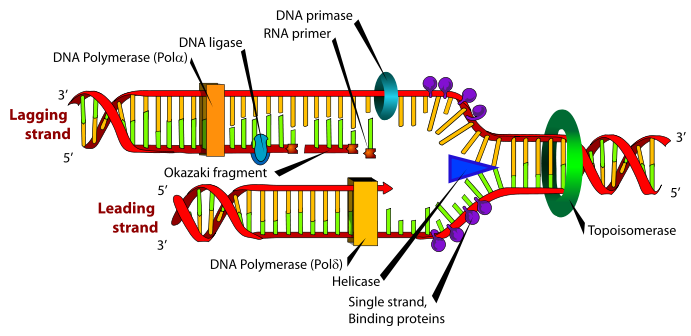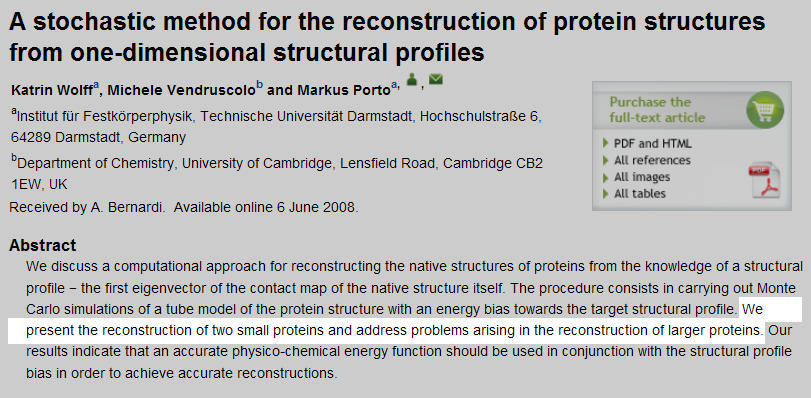Introduction to Biology
- Introduction.
- "Genetics" Exposed.
- "Genes" Exposed.
- Brief overview of correct programs of living of cells (and organisms).
- Brief overview of some other basics of "genetics".
- Biological Evolution.
- Requirements. Means. Preconditions.
- Some Basic Characteristics of the Beginning and Flow of Biological/Molecular Evolution.
- Force of Biological Evolution.
- Mutations and Natural Selection.
- Rate and Causes of Mutations.
- HMT: Sexual Reproduction, etc.
- Growth of Multicellular Organisms.
- Differentiation of Cells.
- Pattern Formation.
- Aging.
- Characteristics of Development of Embryo of Complex Species.
- Regeneration.
- Optimality of Organisms.
- Chromosomes.
- Life.
- Comparison to Modern Science.
- Inapplicability of Modern Fundamental Sciences.
- Pattern Formation Based on Reaction-Diffusion Systems.
- Pattern Formation Based on Positioning Information.
- Conclusion.
1. Introduction
I still don't provide all of the underlying unity and completion (because of NDA with myself),
but, nevertheless, I decided to finalize a few of my thoughts, which I touched in some of the previous articles,
before I abandon this site and writing on science and KOE.
In this article we will overview a little some of the basics of biology (what is partially or mostly unsolved problem of modern science), like growth and development of organisms, biological evolution, life, and some others,
and also we will analyse some of the mistakes in modern biology, and of some other sciences, which are essential for understanding biology.
It shows the way to correctness and completion in biology,
the direction to transfer it to the area of exact sciences,
what opens the door to predictability and correctness of the results and thus control over biological processes.
It is assumed that you have read the previous article on chemistry ("Introduction to Chemistry") and are familiar with correct chemical interactions.
Understanding correct chemistry (and some of the adjacent areas) is one of the most important things in understanding the basis of biology.
Sometimes I cite other sources, but the key thing here is that most of the referenced materials is generally accepted knowledge and one particular source can be replaced by other and most of them will represent basically the same information.
Also I highlight in citations the exact phrases being discussed, so the visual representation may differ (in colors) from the one you'll find at source.
2. "Genetics" Exposed.
2.1. "Genes" Exposed
Space.... kinds and states of matter and energy.... molecules and atoms.
Molecules and atoms interact, there are basic substances with their respective properties, and a lot of other basic and high level stuff,
but,
let's consider some atom or molecule.
It occupies some space.
It interacts with surrounding objects (at least, or also through gravitation.)
Now let's consider atom or molecule more closely.
Let it be not a single atom but a complex molecule, to have more characteristics of this object.
Let's imagine there are no objects around.
It actually does not matter what properties to consider now, the only thing that matters here is the quantity of characteristics we can find/introduce/see about this molecule.
So,
- there is some amount of atoms in the molecule,
- it has some spatial shape, or structure,
- each atom has some amount of bonds with neighboring atoms,
- each bond in the molecule has some value of strength,
- each atom has mass,
and there can be atoms of a little different kind with different masses, and, as a consequence,
with different values of energy and distinctions in other properties,
- (and a lot of other characteristics ...)
You can compose dozen, hundred or thousand of statements about (or characteristics of) molecule,
and there will be one common thing about all of them:
- all (I'll repeat it: ALL) of them concern exclusively this molecule.
Looks obvious.
Another fact about this (isolated) molecule is the following:
it stands (or hangs in space) still or moves with constant speed.
Next.
Let's imaging/consider this molecule with some other objects around.
Now they interact.
Through gravitation, or also through other forces if objects are close enough.
These interactions influence the molecule under consideration.
It either changes its speed and/or direction, and/or causes some changes in the structure of the molecule.
This means that changes in behaviour of the/each object are (partially, or mostly) defined by its interaction with surrounding objects/substances.
Again, all is obvious and clear.
And.... here comes the killer ))
|
Citation from the article "Gene" at wikipedia.org:
|
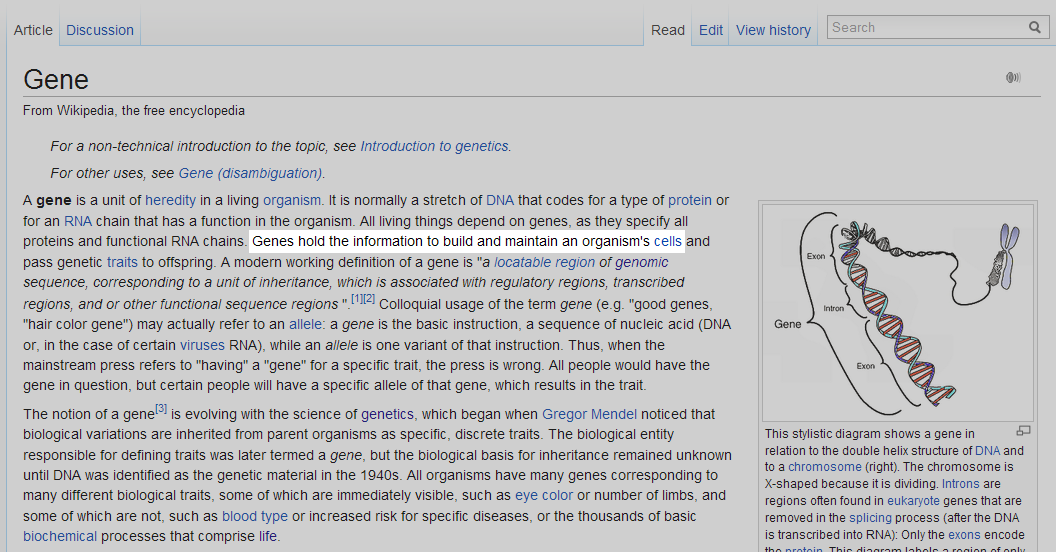
|
8/
Voilà!
Genes DO NOT HOLD the information to build and maintain AN ORGANISM'S CELLS !!!!!!!!
!!!!!!!!!!!!!!!!!!!!!!!!!!!!!!!!!!!!!!!!!!!!!!!!!!!!!!!!!!!!!!!!!!!!!!!!!!!!!!!!!!!!!!!!!!!!!!!!!!!!!!!!!!!!!!!!!!!!!!!!!!!!!!!!!!!!!!!!!!!!!!!!!
!!!!!!!!!!!!!!!!!!!!!!!!!!!!!!!!!!!!!!!!!!!!!!!!!!!!!!!!!!!!!!!!!!!!!!!!!!!!!!!!!!!!!!!!!!!!!!!!!!!!!!!!!!!!!!!!!!!!!!!!!!!!!!!!!!!!!!!!!!!!!!!!!
!!!!!!!!!!!!!!!!!!!!!!!!!!!!!!!!!!!!!!!!!!!!!!!!!!!!!!!!!!!!!!!!!!!!!!!!!!!!!!!!!!!!!!!!!!!!!!!!!!!!!!!!!!!!!!!!!!!!!!!!!!!!!!!!!!!!!!!!!!!!!!!!!
!!!!!!!!!!!!!!!!!!!!!!!!!!!!!!!!!!!!!!!!!!!!!!!!!!!!!!!!!!!!!!!!!!!!!!!!!!!!!!!!!!!!!!!!!!!!!!!!!!!!!!!!!!!!!!!!!!!!!!!!!!!!!!!!!!!!!!!!!!!!!!!!!
!!!!!!!!!!!!!!!!!!!!!!!!!!!!!!!!!!!!!!!!!!!!!!!!!!!!!!!!!!!!!!!!!!!!!!!!!!!!!!!!!!!!!!!!!!!!!!!!!!!!!!!!!!!!!!!!!!!!!!!!!!!!!!!!!!!!!!!!!!!!!!!!!
!!!!!!!!!!!!!!!!!!!!!!!!!!!!!!!!!!!!!!!!!!!!!!!!!!!!!!!!!!!!!!!!!!!!!!!!!!!!!!!!!!!!!!!!!!!!!!!!!!!!!!!!!!!!!!!!!!!!!!!!!!!!!!!!!!!!!!!!!!!!!!!!!
!!!!!!!!!!!!!!!!!!!!!!!!!!!!!!!!!!!!!!!!!!!!!!!!!!!!!!!!!!!!!!!!!!!!!!!!!!!!!!!!!!!!!!!!!!!!!!!!!!!!!!!!!!!!!!!!!!!!!!!!!!!!!!!!!!!!!!!!!!!!!!!!!
!!!!!!!!!!!!!!!!!!!!!!!!!!!!!!!!!!!!!!!!!!!!!!!!!!!!!!!!!!!!!!!!!!!!!!!!!!!!!!!!!!!!!!!!!!!!!!!!!!!!!!!!!!!!!!!!!!!!!!!!!!!!!!!!!!!!!!!!!!!!!!!!!
!!!!!!!!!!!!!!!!!!!!!!!!!!!!!!!!!!!!!!!!!!!!!!!!!!!!!!!!!!!!!!!!!!!!!!!!!!!!!!!!!!!!!!!!!!!!!!!!!!!!!!!!!!!!!!!!!!!!!!!!!!!!!!!!!!!!!!!!!!!!!!!!!
ALL (I'll repeat it twice: ALL, ALL!!!!!!!!!!!!!!!!!!!!!!!!!!!!!!!) information THAT DESCRIBES molecules called "genes" DESCRIBES EXCLUSIVELY THESE molecules !!!!!!!!!!!!!!!!!!!!!!!
A CELL IS DEFINED by ALL(!!!!!!!!!!!!!!!!!!!!!!!!!!!) ATOMS of A CELL.
So, let's sum up, what do we have.
Genetics at the very basis has (or is built up on) absolute nonsense. PERIOD.
This (reference to "genetics") increases a little bit the value of the reasoning we made above (before the citation), so let's come back and provide a little of substantiation to it, especially the ones which should make obvious the case with "genetics".
Let's provide analogies which can be considered as some kind of proof:
- Two (working) hard drives can store more information than only one of them.
- (Amount of) Information contained in one molecule + (amount of) information contained in other molecule ≠ (amount of) information contained in only one of them.
- One component from a set of (non-empty) components of a cell is ≠ to the whole cell.
And, more strict proof... ))
- 1 + 1 ≠ 1
Another variant:
- chromosomes + the rest of the cell ≠ chromosomes
- ... and you can compose a lot more.
2.2. Brief overview of correct programs of living of cells (and organisms).
Most of the organisms contain a lot of interacting molecules.
A lot of organisms consist of cells.
Cells in turn contain complex (and not very complex) components.
All of these components and molecules interact, and, obviously, it's pretty complex process, since large amount of molecules is involved which either interact directly as neighboring molecules, or affect other (distant) parts of a cell through intracellular liquid, interacting with the liquid and dissolved molecules and changing the quality of the surrounding solution, which dissociates and affects other parts of a cell or other cells.
- All molecules matter and define properties of an organism, especially the ones which constitute the structure of a cell and of its components.
Next pretty important thing to note (once again):
- It's impossible to restore the whole cell from chromosomes/"genes" alone (in usual environment at earth where biological organisms exist).
They simply do not contain the information about the whole cell, and only about themselves.
So, what the program of a cell is then, and how organisms appear from a cell,
especially if to go a little further and notice that a cell actually represents information only about itself and not the information about the whole (future) organism.
First, few of examples concerning existence of cells,
imaginary experiments, but if you'll repeat them with real (laboratory) cells (for instance of a mouse or a fly) you'll get basically the same results.
- Cell exposed to fire (or pretty high temperature) will not be developed to the whole organism, or its part,
as it should be expected according to "encoded genetic information" inside of some components of a cell,
and most probably will burn or dissipate in other way.
- Gametal cell (of multicellular organism) transferred to Mars or Moon and exposed to open "air" will not develop to the whole organism, or its part,
as it should be expected according to "encoded genetic information" inside of some components of a cell,
and most probably will die and dissipate over some period of time.
- .....
(Yeah, I know that these examples may seem stupid, but we should go through these kind of experiments to be clear about the basis, about what's actually written/programmed inside of cells/chromosomes, and what's not,
and, more importantly, it provides a little of substantiation to the next conclusion and shifts thinking towards correct perception of the process of development of a cell, which we will touch further).
Now we can go a little above and imagine some laboratory organism (let it be mouse, or fly) on the Moon or Mars, or in water.
We will not see in this case either the program that chromosomes would be supposed to express, like for instance some average period of life for respective species, the process of senescence, and similar.
These laboratory organisms would quickly die, and then dissipate.
Because,
the program (of living/change/development of something) is defined by environment,
or, to be more correct, by interaction of exact organism/cell with environment.
Molecules, cells and complex organisms represent themselves, they do not contain uniform information (independent from environment) on how they should develop or exist further with flow of time.
The program of execution of cell/organism makes sense only in the context of "cell + environment", or "organism + environment",
because it is the environment, who actually changes cell/organism and defines their development and behaviour, by providing molecules/particles to build something from, or to be used as stimulus to change and react for (from point of cell/organism), or affects organism in other way (like, for instance earth keeps organisms at or close to surface and influences running of some of the processes in organisms).
This was one of the basic key points to keep in mind for smooth and correct understanding of behaviour of cell/organism, or of development of a cell to a body, or development of a molecule to a cell, or evolution in general.
- There's no program in a cell on how to grow. There are no additional atoms inside of atoms of a cell which would expand to the whole organism.
Environment interacts with a cell and supplies molecules and atoms to the cell (be it unicellular organism in environment, or one particular, and maybe growing, cell of an organism).
The cell interacts with these molecules and changes accordingly to supplied atoms and molecules (and may provide some output to environment).
- All of the (structure of a) cell holds heredity information (for specific environment).
This was very basic view on existence and growth of biological organisms.
Now let's spend a few more paragraphs on "genetics" to consider a little more closely the state of affairs there and compare it a little to reality.
2.3. Brief overview of some other basics of "genetics".
It's obvious that such absolutely inadequate concept like "genes" could not lead far (even in the wrong direction),
so it had to be (and was) "corrected", or complemented by some other (very) basic things of "genetics".
Let's take a look at some of them.
Next by importance, or probably the second major (except the "genes" themselves) basic concept is about active and inactive "genes" (should be the same or about the same as dominant and recessive "genes").
It means (about) the following: some "genes" are active (and thus respective traits expressed) in some periods (and/or in some places of organism) and not active in some other periods or places.
Some "genes" are not active and don't express themselves, for instance at first stages of development (or in ancestors) and then with development of a body in particular cells of some particular organ (or is passed to some specific level of offspring) these "genes" become active, or begin to interact.
Let's jump right to the essence of this additional concept of "genetics", three times.
(1) It gave the ability to fix "a little" ....hmmm.... "incomplete" concept of "genes",
as the fact that "genes" have all heredity information and information "to build and maintain an organism's cell" was "a little bit" inconsistent with observable reality,
which was showing (for instance) the following:
... e.. hmmm... eh.. e .... yeah, no words, only emotions.... 8/ .... ))
!!! And still it's not enough to see that there's "something" wrong with "genes" and they HAVE practically NOTHING IN COMMON with defining of traits/functionality/etc of cells !!!
!!!!!!!!!!!!!!!!!!!!!!!!!!!!!!!!!!!!!!!!!!!!!!!!!!!!!!!!!!!!!!
"... different cells can have very different physical characteristics despite having the same genome."
"... different cells can have VERY DIFFERENT physical CHARACTERISTICS despite having THE SAME GENOME."
"... different cells can have VERY DIFFERENT physical CHARACTERISTICS despite having THE SAME GENOME."
This had to raise some pretty serious questions about "genes".
Let "genes"/DNA be A, and the rest of the cell be B.
If two/many different cells have different properties, and it is known that component A in each cell is the same, then....
shouldn't from this follow that
(a) component B is different in each cell, and
(b) "genes"/DNA ("with a few exceptions") have nothing in common with defining of the diversity of properties/characteristics of cells.
Hmm... interesting... isn't it...?
But, anyway, we were talking about active/inactive "genes", the very concept which "fixes" this very small and very unobvious inconsistency.
(2) There's usually a lot of high-level information about dominance/recession of "genes", which may be overcrowded with frightening (still high level) terms, what in such a way pretty severely veils basic stuff, but we'll skip it all through right to the basis, molecular mechanisms of dominance:
"DNA makes RNA makes protein". "In this process, different alleles at a locus may or may not be transcribed".
It "typically occurs when one of the two alleles is non-functional at the molecular level, that is, it is not transcribed or else does not produce a protein product."
It occurs when few of the molecules are non-functional at the molecular level.
There's part of a molecule. It has some of it resources directed to, or being spent on support of the bonds to other atoms of the molecule, it should also (as other atoms of this molecule) interact (maybe indirectly) with surrounding molecules, also during replication, but....
it is non-functional.
It's as if some part of a molecule is non-existent in reality, otherwise it cannot be non-functional.
You cannot turn off basic physical laws for some period, like switch off gravitation for a few hours or chemical properties.
This second concept of "genetics" is inconsistent:
(a) with process of replication of DNA, since if one part of a molecule is non-functional, then the whole string cannot be replicated,
(b) with physical reality.
Also you will not find explanations of how to treat space occupied by non-existent/non-functional atoms of a molecule, or other particularities of this process.
So, it (1) conceptually "fixes" "genes", (2) basically is not very consistent with physical reality, BUT
(3) It introduced (if to close eyes on 1 and 2) unbelievably convenient and flexible means for carrying out explanations with unbelievable ease.
- And this was what defined the great success of "genes" and "genetics" in general.
These "genes" are active and those are inactive and we have property A, expressed by corresponding active "genes".
Then those "genes" (or "gene") will be active and these/that will be inactive for some period and we will have property B, or in the other words, now "genes" which carry information about property B of a cell are expressed.
Now these "genes" are dominant and those in that place during that period will be recessive, and we have representation of n-th property, ("encoded" in some corresponding "gene" or "genes").
That's it. Ready.
There are a lot of "genes" in chromosomes,
and one can assign to each "gene" (or to several "genes") separate trait of an organism,
and, probably the only thing to worry about, is to not overlap functionality and periods of existence/non-existence of "genes", and make the whole combination of positions in organism with periods of activity/inactivity different.
Funny enough, but while writing this part of this article, I entered in search string "active inactive genes", and the very first proposed link was the following:
)))
Hurraaaaaaahhhhhhhhhhh!!!
And still they're functional!!!
Yeahhhh... )))
The truth struggles through, though... still hopelessly.
And the referenced Cell paper has the following summary:
Yeah, it's amazing, and even may seem unbelievable, but such is a reality:
if a molecule exists, then it interacts with environment, and it cannot be "non-functional" or non-existent.
Of course molecules, that was thought to be inactive, appeared to be active, or functional,
and of course this extends on other cells of an organism, and, as authors rightfully concluded, it "is a general phenomenon in human cells".
And I can add more: human cells obey to the same laws of the universe as all the other physical objects and substances in the universe, and thus we can extend basis of these observations not only to all human cells, but on the whole universe: all existing atoms and molecules are functional, and not only the ones in human cells ))
And of course you can find tons of other evidence that all observable molecules (including the once that reside in cells) are functional,
and cannot not exist in reality (even for some period) and not interact with environment.
(And if to be physically strict, we should add here: if to consider atoms at earthbound biological context, or at ordinary environment and physical conditions we have at earth).
There are also other (minor) concepts which try to "fix" further "problems" of "genes" and "genetics", as you could notice one of them in one of the previous citations, which is called "Junk DNA" (which was extended also to RNA), but we're not going to consider more of such stuff in this article, and you can apply similar scheme as we did for active/inactive "genes" to demystify them.
Again, the cell defined by the whole cell, DNA defines DNA and cannot have more information to define more than itself (like the whole cell or an organism), properties of a cell are defined by complex interaction of all components of a cell, properties of an organism are defined by complex interaction of all components of an organism, program of a cell or organism is defined by "cell or organism + environment" (by their interaction, and mutual influence).
My head is spinning.
No more "genetics" ))) (after completion of this article)
3. Biological Evolution
Molecules.... cells.... organisms.... evolution....
It probably would be better to start from the very beginning of biological evolution, and increase the complexity in chronological order, adding new macro-rules.
And, besides, by comparing correct knowledge to modern science we will provide analysis of mistakes at basis of modern sciences, what itself is invaluable information and shows the ways to correct these mistakes and basic directions of development.
3.1. Requirements. Means. Preconditions.
Humans. We have abilities to think, observe environment, and some others.
Planets, galaxies, some non-standard effects like evolution of the universe, stars and of other cosmic objects, expansion of the universe, and others physical effects and phenomenons.
Earth. It has mostly similar basic physical properties to observable surrounding cosmic objects, like other planets, or satellites like Moon, or comets.
At surface of Earth we have some increased complexity of forms and behaviour, which is represented in diversity of biological organisms.
Sciences.
There are a lot of them.
For pretty long they remained pretty distinct.
Own views, rules, strategies of development.
Some of them are so distinct, that it looks that they exist in parallel reality.
With own basic physical laws.
Mostly forgotten by exact sciences, like physics and mathematics.
Biology....
Bright example of one of them.
Basically, (as we see, is) almost completely different, parallel physical (and mathematical) reality.
From the other side it could not be the other way.
If you cannot come and make clear and correct order, there's nothing to take as absolute basis, and scientists develop knowledge according to own (differing) views.
Abilities of human brain are very limited. And there's a lot of diversity in views, because of overwhelming complexity of surrounding reality and corresponding knowledge, which are hard to fit in one brain.
And it's logically, that in such environment basis of biology was developed mostly according to views of biologists.
But, if to abstract mind from all of these sciences and separate areas, zoom out, and keep some basic view on this things,
the basic fact will remain the same/following:
all of this is the same reality, and biology is not special parallel reality governed by some magical fuzzy laws, and at basis it consists of the same physical atoms and molecules, the same basic physical laws.
But, let's finally start to cover the subject )
Physicists will tell you that Earth previously did not have all of this biological diversity, that even all of the surrounding cosmos was different, it was in a little (or pretty much) different state, with different processes or different characteristics of processes dominating.
And I completely agree, and can confirm that this is true.
And we still observe these continues transformations.
(And we considered a little the reason of expansion at this site).
Then, during some basic physical evolutionary processes, appeared stars, planets and other cosmic objects.
These evolutionary constant changes persist/continue, we see the red shift or accelerating expansion of the universe, and, obviously, things basically are changing, and will change pretty significantly in the (very far) future,
but, for the following (at least) hundreds of billions of years all of this (basic physics as we see it around) will remain more or less the same.
This is the first approximation of the largest period where actually all of the biological forms and processes may be possible, the period of evolution of the universe as we observe it in current state, with atoms, molecules and all the other stuff.
At some point there appeared solar system, with Earth orbiting around the Sun. The Earth had simple basic components and their interactions:
- atoms,
- simple molecules,
- liquids,
- amorphous substances with simple structure, or simplest molecules involved,
- crystalline structures,
- vaporization, condensation,
- and other basic processes with simple basic components.
Then stuff started to complicate, appeared biological forms, they passed biological evolution and we see all of the diversity of species and of their behaviour.
Organisms have some abilities which may seem sophisticated, but let's start to select some of their most important basic properties:
- There are very simple organisms and very complex organisms.
- (A lot of) organisms can reproduce themselves.
- There is large variety of organisms, usually called species.
- Some of the organisms/species can grow, usually from more simple forms, like one cell, to something (much) more complex, like multicellular organism.
- Organisms live, change, and eventually die.
- Organisms have very similar basic elemental base: all consist of atoms, at the basis is used some limited amount of atoms from all of the variety of atoms, the basic molecules used in organisms are very similar for a lot of species, more complex species usually have complicated or changed parts of more simple ones and may add something new (usually in bounds of generally used basic elemental base).
- Organisms have some level of complexity of behaviour and of (physiological) changes (during interaction with environment).
- And some other stuff....
(And, all of this still is the same reality that we consider in other areas, the same basic components, the same basic physical laws.)
Now, let's map (most) of these high level characteristics of biological organisms to the basic stuff we already know from previous article about behaviour of atoms and molecules,
by considering chemical interactions and drawing correspondences to the basis of biological processes.
All of the (four) items below have the same physical basic processes, but they are split to classes of behaviour/interactions, characteristic for distinct high-level representations:
- Complexity of encoded/stored (in each component/atom) [abilities of] behaviour.
The complexity caused by the key basic properties of chemical/molecular/atomic interactions:
- gradual change of force between atoms with change of distance between them,
- redistribution of interactions (and thus of forces) between bonds throughout the molecule with outer influence,
- superposition of interactions/forces,
- ... and some other things.
This basic complexity gives the following:
- large diversity of abilities for interactions between atoms/objects,
- large number of possible states these atoms/molecules can transition between (but in exact moment they have, or represent ONLY ONE of them).
And this representation of the complexity at basis which stands behind the resulting complexity cells and organisms have.
This difference is especially obvious if to compare correct chemical interactions to descriptions in modern science, where neighbouring atoms may have two states: have bond / don't have bond, what is nearly complete ignorance of complexity of reality,
and as a result there's nearly complete absence of means to substantiate the complexity we observe at high-level representations.
These are the examples (from the previous article) of how reaction/interactions may run, and how interactions are being gradually redistributed:
- Complex structural/developmental changes.
Propagation of interaction over the atoms of a molecule with possible superposition of influences from different outer points of the molecule provides a lot of abilities for changes in the structure of a molecule.
- Even without formation or break of firm bonds, interaction with other atoms and molecules can change spatial structure of a molecule, because of changes (and propagation of these changes) of strength of bonds between atoms.
- Interaction at one point or several point of a molecule with outer atoms/molecules can split molecule or one/few of its bonds, even without formation of firm bonds at points of interaction with outer atoms/molecules.
- Interaction at one point of a molecule may change and split bonds in different parts of this molecule, not neighbouring directly with the point of interaction.
Below is (schematic) example (from the previous article, and more detailed description of this scheme is given there) of possible interactions of atoms and molecules.
- Recognition of molecular patterns.
Some of the features of interactions we already know are the following:
- Spatial change of the structure of the molecule during interactions, because of change of strength of bonds.
- Superposition of interactions from different points.
- (Possible) Formation and break of bonds.
And obviously these properties of atoms and molecules are expressed in more high-level activities like:
- Recognition by unicellular organisms of, for instance, their food, that they are able to process.
- Intercellular diffusion of specific molecules, where only molecules which can create specific superposition in specific places of membrane can bend it, or break (may be temporarily) some links.
- And a lot of others...
The structure of a molecule can be considered like a key, which can fit to other molecule at specific part and cause specific significant changes.
- Replications.
This one is already obvious, since it is based on the previous two: complexity of interactions and recognition of molecular patterns,
and basically directly on the properties of chemical interactions.
Replication of a molecule (like the same DNA, or membrane, or other part of a cell) can start and complete only if suitable/specific molecules join this one at specific places, which create superposition of forces leading to break up of internal forces and formation of new once with ultimate formation of two identical/similar molecules to the initial one.
Also, once the process started, it introduces propagation of changes in the links of a structure of molecules, and directs or facilitates further changes.
Diversity of basic parameters of basic components (different masses, energies, forces) corresponds to, or creates the resulting diversity/complexity of interactions.
And let's consider very primitive schematic example of replication, what can be membrane, or any other part of a cell that undergoes replication during cell division or other processes.
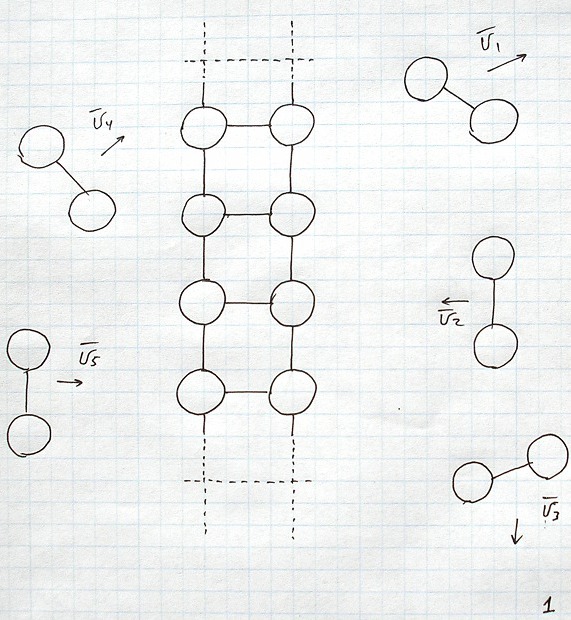 |
This is an ordinary intracellular environment:
- There's part of a structure of a cell, or of its organelle.
- Intracellular liquid is implied and not shown.
- The molecules which interest us (which "fit" this structural molecule) are highlighted (shown),
- and they have a little different speed and random directions (which may pretty often change because of interactions with liquid and other dissociated molecules).
|
 |
Now one of these molecules comes close enough and starts chemical interaction with structural molecule.
- Arrows show redistribution of interactions, and
- dotted lines around bonds (of the structural molecule) show that this process propagates further over the molecule.
- ∆1 is the amount of "strength" upper bond lost, and
- ∆2 is the amount of "strength" the next bond lost.
- Two dotted lines on the left show formation of new bonds.
|
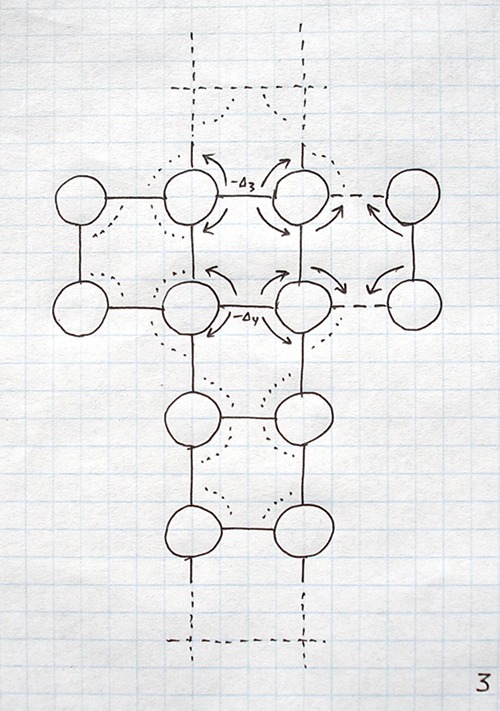 |
On this picture we see that another molecule joins on the right.
It could happen that some of the molecules joined this structural molecule below, before this one came to this place, but we consider them in this order.
The process is principally the same as for previous case,
but now two middle bonds of this structural molecule suffer additional loss of strength (∆3 and ∆4 respectively).
This loss was crucial for these bonds and they lose firm joints,
what is shown on the next image.
|
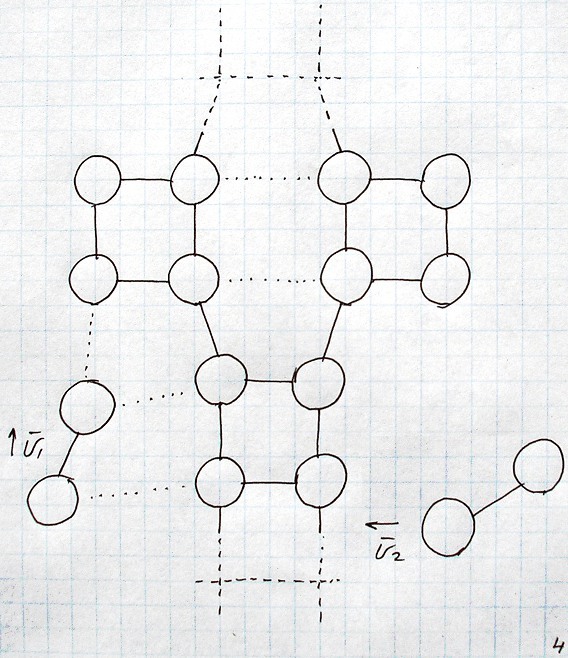 |
Part of the firm bonds of the structural molecule of a cell is broken.
Eventually other "fitting" molecules will join the rest of the structural molecule and will complete replication.
Obviously, accuracy of this process depends on exact characteristics of each structural molecule and on quality and amount of dissolved components in the liquid.
These parameters were pretty thoroughly sharpened by evolution.
|
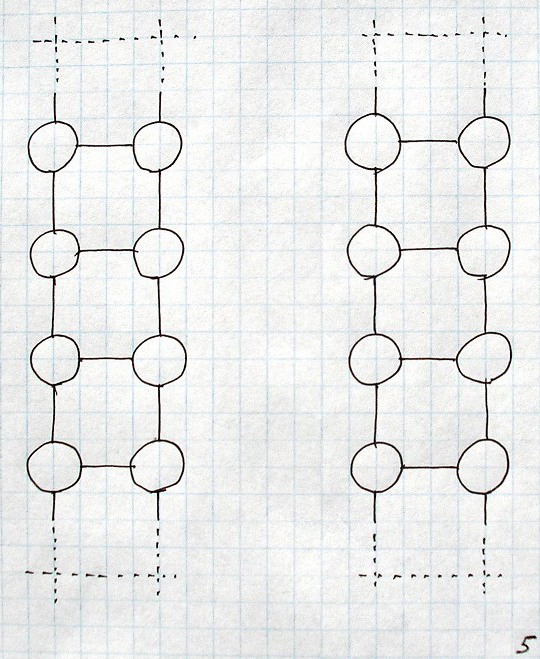 |
Now the replication is complete and we see two similar, or identical molecules, which can be membranes or other molecules.
|
Again, again and again...... VERY IMPORTANT NOTEs:
- There is no "control center" which would define all of the particularities of this processes at each point of a cell, and
- each molecule embodies all of the basic features required to carry out, or support all of the complexity of biological life, and
- they are the same at the basis (a) of simple molecules, (b) of components of a cell or (c) an organism,
or, in the other words,
at the basis of complex cells and organisms are molecules and atoms with basically the same properties (but a little different parameters).
To sum up (or repeat) these items:
large amount of possible states/changes during interaction provide large abilities for (1) behaviour and/or (2) complex structural changes,
(already with just a few molecules involved).
This point was repeated and highlighted for several times already, and I'm trying to deliver pretty clearly all this basic atomic and molecular stuff,
because this is one of the most crucial points in understanding of biology:
it shows where from all of the biological complexity and diversity appears (more correctly: where it exists).
The previous article gives some (a little) more complete basic approximate representation of the complexity of basic chemical and adjacent atomic interactions.
And there's one thing, which should be clearly understood, before any further consideration of biology:
Biology is just a natural continuation of (mostly) chemistry.
This is the same physical reality, and biological organisms are based on basic chemical (and adjacent) interactions.
Actually, both words/areas, chemistry and biology, could be omitted, and it can be considered as long, continues, complex physical evolutionary processes and transformations.
It would be more nice to rephrase one of the previous sentences in this way:
Biology is just a SMOOTH natural continuation of physics and chemistry.
Even the very first organisms (complications of molecules) are already basically full-fledged.
(And there's no specific atom (or molecule) which holds all of the complexity or information characteristic for cell or organism, it's distributed between all atoms,
and they have basically the same properties, with a little different parameters, like mass, etc.)
There was no jump between basically conceptually different stuff, like from atoms to organisms, with non-existent middle part.
It is very smooth process of complications.
There could not appear something out of nowhere.
The complexity of the basic processes, characteristic to atoms (and their interactions), naturally continues to exist in molecules,
and in more complex molecules, and in cells, and in their interactions, and in organisms...
Some of this stuff is considered in more details in following chapters.
3.2. Some Basic Characteristics of the Beginning and Flow of Biological/Molecular Evolution.
Earth. Atoms. Simple molecules. Most of them interact with neighbours.
And sometimes, at some places happen coincidences and atoms and molecules make (random) complex compounds.
If to consider particular interacting atoms/molecules, their environment has atoms and molecules in form of gas, liquid or solid,
and the concentration of atoms and molecules for exact place, height, and other conditions differ.
And different environments may promote creation of complex molecules of specific types,
or may promote their decomposition.
Yeah, this is standard stuff,
and in some place with some specific concentration of specific atoms, started to appear basic molecules of the kind, which become the elemental base of the biological life we observe around.
From point of understanding the essence of the process, most of the details do not matter much, like the dimensions of initial environment(s) which facilitated this process, or amount of first complex molecules, or exact concentration of exact elements, etc.
As first approximation we can say, that such environment should be pretty big, and stable over some period of time, to support development of first forms of life (complex molecules), until they reach some level functionality and stability of structural forms, which would give the ability to leave this facilitating environment and survive in more rough conditions.
Spreading of simplest organisms, paved the way for spreading and appearance of more complex forms/organisms, since they require food.
It could be, that most of the surface of Earth had facilitating condition for development of complex forms of life.
All of the exact details do not matter here.
One of the significant notes that should be added is the following:
In general,
- It's absolutely not obligatory to have complex forms of life exactly on the elementary base we have at Earth, with preference of exactly of the chemical elements that are used in [biological] organisms at Earth.
So, the statements/restrictions like: to have conditions for complex forms of life there must be atmosphere with some specific temperature and some specific concentration of oxygen and nitrogen and of something else in the air, there must be water and its percentage should be at least some specific value, etc.,
are ABSOLUTELY WRONG.
We have/observe, some specific preferences of elementary basis of complex life at Earth, because there was/is abundance of these elements at Earth,
(and most suitable elements and compounds were chosen by chance and evolution.)
But, basically, there are just a few main conditions for development of complex forms of life:
- There should be some motion of atoms and molecules,
so that they mix/diffuse and interact and there's some probability that complex compounds appear.
- There must be some minimum diversity of elements,
since similar atoms and molecules would create only uniform structures, like crystalline or similar.
- There should be source of "quick" energy, so that the process could be fuelled and supported.
It may be thermal energy of a planet, or the energy that goes from stars, etc.
At Earth the beginning stage of evolution it could be thermal and solar energy, which was stored in form of bonds in molecules, and then these molecules were used to power other processes/reactions/changes.
At later stages of evolution at Earth it was mostly solar energy, and a lot of organisms use stored solar energy indirectly, by consuming other organisms, which stored it or in turn consumed other organisms which stored it.
At the image below is an example of the conditions, which greatly facilitate start of evolution of complex molecules, like: increased diversity of components, different sources of energy (thermal and solar), liquid facilitates chemical reactions and transfers/diffuses elements and molecules all over the volume of water, etc.
(It's not that exactly such conditions are required. Development of complex forms of life could happen/start and run in environment that significantly differs. But such conditions, like in the image below, besides possible other useful factors, facilitate and accelerate the process.)
I expect billions of years ago at Earth could be much larger dimensions of such environment, or environments, but basically this is direct analogy for one of possible environments:
|
Image from the article "Life" at wikipedia.org:
|
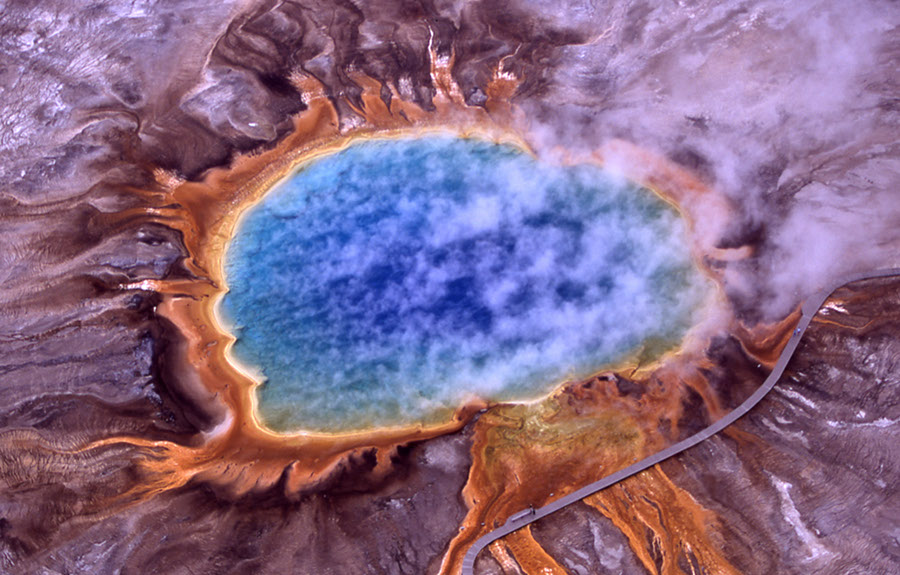
"An aerial photo of microbial mats around the Grand Prismatic Spring of Yellowstone National Park."
|
Now let's overview some very basic characteristics of evolution from simple to complex biological forms.
- Beginning stage has, as we described above, atoms, simple molecules, liquids, crystalline structures and similar basic stuff.
Or, in the other words, primitive forms of life.
- With some probability may appear more complex molecules.
- In environments rich by diversity of atoms and molecules, more complex molecules have ability to be replicated by environment.
- And.... the flame begins...
With some probability they encounter changes which complicate their structure,
and with some probability they survive... and... the result we may observe around.
- The more complex molecule or organism, the lesser probability that it can appear from very simple components, like single atoms and very primitive molecules.
- At some point there was one/several/some number of most successful samples of complex molecules.
- These most successful (which also cold be most complex and most functional) samples (or threads of development of organisms, as in picture below) gave the beginning to all of the modern diversity of organisms, by (a) reproducing/replicating themselves, and (b) mostly suppressing possible parallel evolutionary threads, which are less functional/suitable, because of limitations of resources.
- And the next phase was creation of large diversity of species mostly on this widely used most successful (and may be complicating and changing) elemental base,
what includes most successful/useful basic molecular, cellular etc. developmental solutions.
|
|
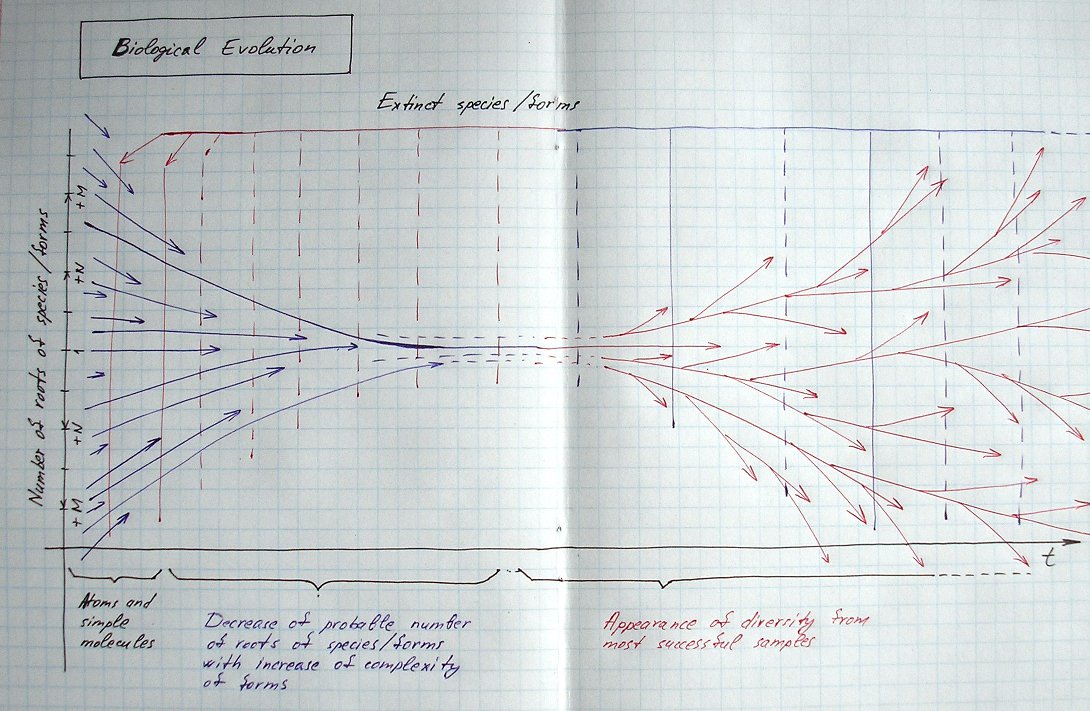
|
3.3. Force of Biological Evolution.
3.3.1. Mutations and Natural Selection.
One of the standard definitions of mutation is like the following (from wikipedia.org):
"Mutations are changes in a genomic sequence: the DNA sequence of a cell's genome or the DNA or RNA sequence of a virus."
what of course is incorrect (for organisms which have more complex structure than only DNA or RNA), and should be renamed to something more limited, like "Mutation of DNA" or "Mutation of RNA".
Mutation, mutable.... THIS IS basically ABOUT CHANGE, and not about "genes" and similar "genetical" stuff.
More correctly would be to say:
Mutation is mutation, or mutation is a change (in an object under consideration).
In biological context we should tie it to molecules of a cell, or of an organism,
and induce some limitations, like "it's abnormal persistent change in a structure of a cell", because there are usually a lot of ordinary changes in organisms characteristic for flow and maintenance of biological life,
and of course with basic note about the fact that mutation may concern any molecule of a cell.
Mutation can happen in chromosomes, but just as in any other part of a cell.
Basic properties and characteristics of mutations are pretty well described in modern science (except major incorrect limitation to only chromosomes),
and let's list some of them:
- Mutation may happen at any part/molecule of a cell.
- To be passed to offspring, it has to happen in a cell (or one of the cells) that will become new organism.
- Mutations are exclusively random, and do not concern any high-level stuff/views like usefulness and similar.
- They are pretty common, and can lead to some defects in organs/skin, and may represent (or become) a disease or may remain "neutral".
- Mutation may happen because of
- non-standard outer influence,
- or as unsuccessful/unfortunate coincidence of molecular interactions inside of a cell, what creates abnormal changes.
- Mutations are main, and the only basic force of biological evolution.
Most of it is well known and pretty obvious, but let's stop at items 5 and 6, to clarify a little item 5
and more thoroughly consider item 6, since modern science roughly contradicts to it.
The matter is that there's such thing like "Natural Selection", and it is still used as one of the basic forces of evolution (in parallel with Mutations and some other factors).
So, what is "Natural Selection"...
Basically, Natural Selection is a process of natural selection of species which are more survivable,
and the once which are less survivable (and have to consume/share the same critical for survival resources as more survivable) become distinct.
Natural Selection.
Natural SELECTION.
Natural
Selection.... from the diversity of species (which share the same critical for survival resources, or are in predator-prey relation, or similar).
Natural Selection from the diversity (of species).
And now we already can see two basic points, which show that Mutations are The Only BASIC force of biological evolution.
-
In general, process of Natural Selection is (wide, but still) special case of biological evolutionary process, and it may be absent at all with biological evolution taking place.
In such a case there has to be two main characteristics: (1) species should appear with only useful features, and (2) bio-system is (in changing, but) in dynamical equilibrium (concerning presence of all of ever appeared species).
Such special case has very low probability for complex evolutionary processes, but (a) it is still probable, and (b) it clearly shows that (strictly speaking) Natural Selection is not inalienable characteristic of evolution,
and thus it cannot be put to THE VERY basis of causes (or forces) of biological evolution.
-
Natural Selection (in general case) is temporary characteristic of dynamical system.
Mutations provide diversity.
Then Natural Selection operates with this diversity.
As basic trait of this period of evolution, we can introduce such basic generalized characteristic as "mixing" of components of cells of different individuals with distinct traits. It can be sexual reproduction, or some other means.
This produces some new resulting forms, (in bounds of more basic changes provided by mutations).
This period of mixing of structural parts should be included in the term, or process, of Natural Selection.
And, without subsequent mutations, obviously, it can be considered at some point as complete.
What means that all possible permutations happened and the once which could survive survived, and the eco-, or bio- system is in dynamical equilibrium, (or in some kind of cycling dynamical equilibrium).
And this is where natural selection ends.
It may appear (as characteristic of evolution after mutation happened), acts for some period, and may disappear.
It depends on the rate of mutations. If it's too high, then Natural Selection is (almost) always present. If the rate of mutations is low, then over some period equilibrium is established (and, thus, Natural Selection disappears, and = at this point biological evolution stops) until next mutation(s) happen, which introduces disbalance and next iteration of selection.
We have pretty severely discredited Natural Selection,
but,
- mutations are random,
- and the fact remains: Natural Selection actually defines the exact way, or direction, of biological evolution,
(selecting exact samples with exact features from all of the variety of random features, and thus defining later, after mutations, the exact direction).
So, let's define the relation between Mutations and Natural Selection.
Natural Selection defines direction, but exclusively in bounds of (random) traits, provided by Mutations.
At first the direction is defined (randomly) by mutations, then direction defines/narrows selection (within what have provided mutations).
Natural Selection is derivative of Mutations.
Derivative... this word in this context came up naturally, but to map more to mathematics, we can compose phrase like this:
Mutations (basic mean of biological evolution) provide number (in our conditions: usually large number) of values for each point (in environment),
and Natural Selection defines direction of evolution at each point.
If specific (ordinary, or promoting) environment is implied, then we can consider one main parameter of evolution, and it can look like the following relation:
Biological Evolutionary Development = f(Mutations)
f'(Mutations) = Natural Selection
3.3.2. Rate and Causes of Mutations.
And, another point about mutations, and biological evolution.
It was estimated that there are about a few of dozens of trillion of cells in adult human body.
Obviously other complex species, like cats, mice, birds, should have also pretty much of cells.
Probably somewhere from billions to trillions.
Frogs, lizards, fish, newts, are also pretty complex and pretty big animals, and can have from millions to billions or more of cells.
Very rough estimates here are enough.
For mutation to be transmitted to offspring it has to occur in a gametal cell, or in other cell which should cause strong changes in organism and affect gametal cell.
Most of mutations provide negative influence and lead to death of organisms.
But, nevertheless, we observe very big advance of biological evolution.
Taking into consideration: (a) big number of cells in relatively complex organisms and above, the facts that (2) period of reproduction and growth takes some time, and (3) there's actually some finite period of time over which it all (surrounding earthbound evolutionary development) has happened,
we see that the rate of mutations should be actually pretty (or even very) high.
There are two main reasons of mutations:
- "non-standard" outer influence (radiation, different food/air/etc),
- self-sustaining mutations.
Complex organisms are far far imperfect and there can be large variety of coincidences in interactions of molecules which can create non-desirable outcomes of reactions and affect structure of a cell, and further organism or its part.
I have read somehow an assumption that first anthropoid apes, or first humans appeared somewhere in Africa because there is a place with working natural nuclear reactors which provide high level of radiation and thus promote quick biological evolutionary development in its surroundings, and then species get spread to other places.
It could take place, and radiation should promote higher rates of mutations,
but the fact is that the diversity of species at different separated continents and islands is (roughly speaking) equal (taking into account proportional relation of diversity to favoured environmental conditions concerning support of life) and most of these different conditions do not have strong sources of non-standard outer influence,
and thus we can say that main general cause of mutations are self-sustaining, or very weak outer non-standard influence.
And we can see one more main characteristic of biological life and evolution of complex organisms:
- Quick (earthbound) biological evolutionary development is caused by some level of imperfection (or instability) of complex organisms, what provides high rate of self-sustaining mutations (or caused by very weak outer non-standard influences).
This pretty high level of imperfection, or vulnerability, or instability is (and now goes pretty long term, but it's pretty fundamental trait of earthbound evolution) force of evolution embodied in organisms.
Organisms could be more stable and internal processes more accurate, but obviously evolution would be much much slower and billions of years wouldn't be enough to develop organisms to millions and billions and trillions of cells (to the complexity we observe around).
And, it did not stop, did not disappear.
As consequence we can say, that there will never be complete list of curable diseases and viruses, etc.
This is not something that appears accidentally once at one stage of evolution.
This is constant indispensable prerequisite of our existence.
We have it. Most of surrounding organisms have this instability.
Quick rate of evolution is proportional to instability.
Bad ecology and food increase number of mutations but is not basic and the only reason.
There's only one solution to this problem:
to have highly-developed equipment and means for carrying out calculations at molecular and cellular level,
to provide quick reaction to new diseases and viruses.
We (and most of other complex organisms) have pretty high level of internal mistakes, vulnerability and instability,
but at the same time this is the primary cause and mean of our development and existence.
We (and other surrounding organisms) have a lot of diseases, and we will have a lot of new diseases, and because of this we (were developed and) exist.
And this internal "contradiction" cannot be separated: life + a lot of (randomly spread over population) diseases, and no way around.
We can only be fixing it continuously, in parallel (to our existence).
3.3.3. HMT: Sexual Reproduction, etc.
Somehow I come across an article, which listed appearance of sex and explanation of its role as one of the "fundamental topics" in evolutionary biology.
It seems that some authors sometimes forget one very basic trait of biological evolution, and particularly of mutations.
And the fact is mutations (and thus provided traits) are random.
Why sexual reproduction appeared? Why some species do not have sexual reproduction?
Why some species can fly (and others cannot)?
Why some species swim?
Why particular species (in normal flow of development) have exactly this amount of limbs, or exactly these specific traits with such properties?
......
And the answer is the following:
because
the chance
happened to be
this way.
This is all of the fundamental meaning and supreme intents behind biological forms and traits, (including sexual reproduction).
It could turn out that all of the surrounding biological forms could be a little, or drastically different.
Though, very large amount of organisms with high rate of mutations has developed so big diversity of forms and species, that it's actually may be hard to imagine what else significantly, or conceptually different could appear at Earth (concerning biology).
It would require changes at the elemental basis that biological life is built on, like different preferences of chemical elements at basis, but this in turn requires different concentration of those elements in environment.
Taking into consideration the ease of start of biological evolution, (since there are just a few basic key requirements),
and the enormous amount of cosmic objects with similar properties (stars with surrounding colder objects which may have diversity of chemical elements and use internal energy, or energy of nearest stars to start and run biological evolution),
we can state that there's actually very high probability of existence of large amount of similar biological evolutions, even in the cosmic surroundings we can observe directly (also with the help of telescopes),
most probably with different preferences at basic elemental base, according to concentrations of elements in particular environment.
Since we started consider this subject in more universal terms, let's draw the line between what's biological and what's not.
And there's only one basic universal characteristic that could separate biological forms from not biological (this is not synonym of life, what we will consider a little later in this article).
It's threshold of complexity of forms and processes.
Despite the fact that it's pretty conditional, there basically cannot be more strict definition.
And, about abbreviature HMT.
Originally it was Horizontal "Gene" Transfer, but, obviously, correct name is Horizontal Molecule Transfer.
According to wikipedia.org (with few obvious corrections, to replace "genetics" by correct understanding):
"HMT is any process in which an organism incorporates (persistent) structural molecular material from another organism without being the offspring of that organism. By contrast, vertical transfer occurs when an organism receives (persistent) structural molecular material from its ancestor, e.g., its parent or a species from which it has evolved."
As said in that article, the carriers may be, for instance, bacteria, viruses or micro-parasites, and maybe some other ways.
From this point sexual reproduction partially or completely falls into this category as sub-class of horizontal molecule transfer.
Or the definition of HMT should be corrected a little, as basically HMT was introduced to cover the case of mixing of molecules from pretty far/different lines of development.
I mentioned HMT, because it looks like it has become pretty fashionable phrase nowadays in biology, but for evolution of complex species (if not to count sexual reproduction) it stands at higher level and is less significant than other means of evolution, like mutations,
because to influence evolutionary development, differing molecule from one organism should be not only transferred in some way to other organism, but into gametal cell.
But, from the other side, obviously, it's very natural way of changes for simplest organisms.
One note should be added to HMT.
In general case, food also falls into this category, as organisms consume other organisms, and the parts of the food (be it parts of consumed chromosomes, or any other molecules of cells) become part of this organism.
To classify HMT according to its role in biological evolutionary development, it stands above mutations (since does not create basic, or very basic changes) and performs the role of mixing of parts of organisms and species where it's possible.
So, it stands in parallel to Natural Selection at the beginning stage of selection (or, may be considered as its introductory, or introductory-and-parallel part), and ends a little earlier before Natural Selection ends, when all possible (or all major significant) permutations have happened.
4. Growth of Multicellular Organisms.
A cell has cover, some internal parts and internal liquid, which are sometimes called membrane, organelles and cytoplasm.
Also there should be environment which supports life and development of cells. It may be open natural environment, like for roe corn, or other surrounding cells, like for instance for internal cell of a tissue, or it may be edge cell of a tissue.
First cell of new organism, with flow of time and interaction with environment starts to divide.
In normal process of development (without anomalies) most of the structural components replicate themselves into copies of themselves.
First new cells are usually principally equal to each other, and their number increases.
Then some of the cells become different and form asymmetries in this mass of cells, which continue to divide and some of them in turn start to differ from other cells in this asymmetric part and in such a way are formed complex organs, limbs, etc.

Development of embryo of some hypothetical species. |
4.1. Differentiation of Cells.
One of the main basic points concerning development of organisms is differentiation of cells.
There's basic gametal cell, or for some organisms cells.
It starts to divide. Appear two, and then more of similar cells.
Then some of the cells change their structure, and as a result functionality and properties.
This is called differentiation of a cell.
Then some of these differentiated cells differentiate, and then those may differentiate also, etc.
Differentiated cells, or groups of cells have own properties and specifics of functioning and dividing.
And thus as a result complex organism is developed.
This was development of an organism in a nutshell.
Now let's consider some of the basic details.
This is an example of a simple organism, or of embryo at beginning stage of development.
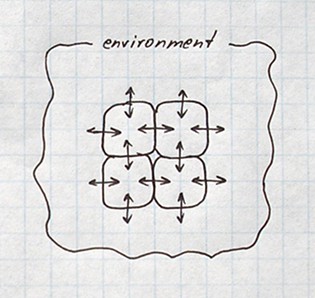
The following main essences participate in this process of development of an organism (some other obvious basic conditions, like for instance gravitation, are implied):
- Internal environment of a cell.
Cell may have pretty complex structure with lots of internal components, internal liquid, they carry out different process and interactions.
- External environment.
It should have (a) physical conditions to supply consistency of a cell and (b) lots of different components (atoms and molecules) to support cell's growth and life.
- Molecular diffusion.
Molecules diffuse through membrane to and from environment and between cells.
Now, before we do any further advance we should stop (once again) and clarify one very basic and crucial thing for correct understanding of biology.
We will return to it later, maybe many times,
but it needs to be very very clear.
If you did not deal with biology previously you may skip it, as stuff will be natural for you,
but for those, who suffered from the influence of "genetics", it may be pretty hard to understand, but it's crucial point.
New atoms, molecules and parts of cells do not appear out of nowhere.
New atoms, molecules and parts of cells do not appear out of chromosomes.
Molecules, and (as consequence) parts of cell can divide.
BUT, all of the new components (atoms and molecules) that these new parts appear from,
originally come from environment, and not from chromosomes.
If one cell divides into two similar cells, and they become (before or after division) similar in size to the original cell,
then it means that all of these new atoms and molecules came from environment.
There can go lot of parallel (to growth) processes with exchange of atoms and molecules between cell and environment,
a lot of these primitive environmental molecules may (or may not) interact with chromosomes and other parts to form more complex basic building blocks of a cell before they are used in replication of specific part of a cell,
but the overall balance is the addition of the amount of atoms and molecules to a cell or an organism (from environment) to form new cells and parts of a cell (or organs of an organism).
This is about complex interaction between components of a cell and between cell and its environment, and not about atoms coming from the chromosomes and building the cell or carrying out other functions.
All parts know how to replicate themselves, they have this functionality embodied,
and the overall complexity of behaviour and development of organisms we observe is based on complex mutual influence of cells and internal components of cells with basically similar (at atomic and molecular level) properties and functionality (but with a little varying specifics of these properties, or parameters).
|
|
|
So, differentiation.
The question basically is about finding out basic specifics of why and when cells differentiate, or change to structurally different cells.
Let's start from this image.
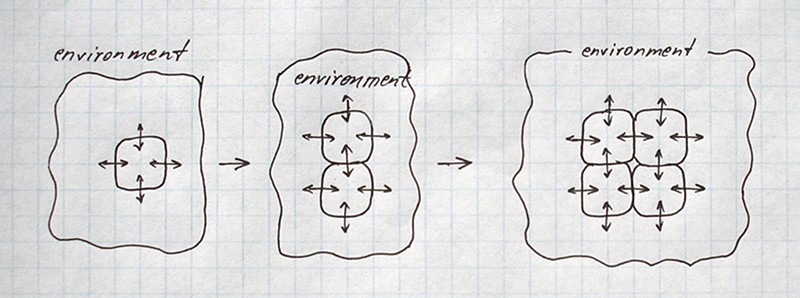
One cell interacts with environment. Over some period of time it may divide.
Then there are two cells.
Now each cell interacts with (1) environment and (2) with other cells.
Actually, we already see drastic difference in the way cells function, compared to one cell interacting with environment.
Most of the main basic properties of internal dynamics of cells (like, for instance, rate and quality of diffusion) start to differ, compared to processes of interaction of single cell with environment, or of smaller group of cells (with environment and between themselves).
They divide further and the changes in all of these dynamics become more different.
Cells have pretty stable bonds inside of components, but there's some threshold of stability (concerning changes of components in intracellular solution and around), after which the structure and processes of this cell start to change.
Or more nicely it would be to say in this way:
supply of different basic components from environment (what may be surrounding cells) to a cell causes different dynamics of reactions and, thus, different outcomes of these reactions:
- the structure of a cell may change after appearance of new molecules or of different concentrations of existing molecules,
- the outcome of replication may be different with usage (or presence) of different molecules, or of different concentrations of previous molecules.
In the schematic case of development of organism (below) the threshold of stability of processes and structure of a cell is defined in the following way:
the structure remains stable until (environment does not change, at least significantly, and) no more than two edges of a cell are occupied by other cells.
The letters should be reversed to have more natural perception )
since B here is the original structure of a cell, and A is changed/differentiated cell, but to distinguish type of cells it's enough.
So, in this example cell B was dividing, and in cases where new cells had two or more surrounding cells, they were differentiating (changing) to cells of type A (because of differences in dynamics of processes).
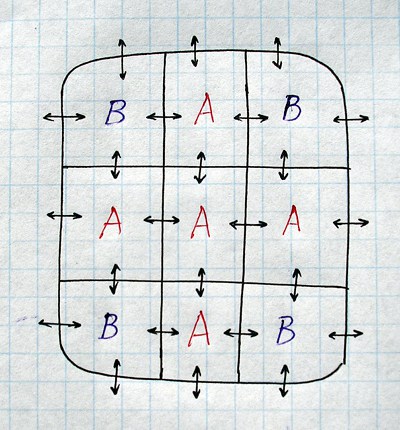
And as a result, differentiated cells differ in structure and specifics of processes.
In this example we considered change of concentrations and processes because of change of edge from environment to other cells,
but in general case there's no need to have such drastic difference, since in mass of cells with a lot of internal cells concentration changes gradually from outer cells to most internal cells, what may create conditions for lots of internal differentiations.
And, next basic step of this process, which actually completes basic understanding of how all of the structural organism complexity appears.
Suppose the organism above continues to develop, and because of gravitation (or other constraints) the cells are laid out along the ground (though we will consider a little below also rounded case of growth) and on the right and on the left remain groups of B cells, while in the center develop A cells.
The cells of type A have molecules and concentrations characteristic for these cells.
Cells of type B have molecules and concentrations characteristic for these cells.
They still may have a lot of similarities (or mostly identical), but also some differences.
The solution of chemicals of cells of type B diffuses towards cells of type A, and from cells A respective characteristic solution diffuses towards cells of type B.

There are membranes along the way, and some spatial distance, what slows down this process (of diffusion, and of growth in general).
Because of this, concentrations of chemicals in solutions, which are being diffused, fade with increase of distance from source (of respective chemicals).
And groups of cells (may) keep stability for some period of growth.
Number of cells keeps increasing, and
cells maintain the processes which support their life and development, and this changes quality of solution, and part of the molecules dissociate to surrounding cells or to environment and backward.
The following factors create and increase differences between intracellular solutions across the mass of cells,
and are the reasons of further differentiations:
- Growth.
- Presence of edge cells with drastically different surrounding environment.
- Membranes slowing down and filtering diffusion.
- Intracellular processes (constantly changing components in solution).
- (and some others...)
And the second key characteristic here is the following (I'm even going to frame it, as this is basic conceptual point of replacement of "genetics" by correct understanding. It's not a question long ago that "genes" and "genetics" is plain wrong and inadequate, but here we highlight, once again, how actually all of the basic stuff happens instead):
|
The quality of solution of differentiated cells (number of different molecules and atoms and their concentrations)
is (in most cases, or in general case) DIFFERENT compared to ANY other solution of cells, previously existing in this organism.
Initially there was one type (or maybe for some species few types) of initial (gametal) cells, which are already fertilized and are to be divided and grown as new organism.
Then appears two different types of cells.
When third type appears, it is already influenced by TWO DIFFERENT solutions from cells of other two types.
Next differentiation (appearance of forth type of cells) will be influence ALREADY by 3 different types of cells,
etc.
It's crucial to understand this CONSTANT APPEARANCE of DIFFERENCE.
THIS constant DIFFERENCES APPEAR because of the reasons we listed above (we found 4 of them),
but if to put it short: because of interaction of a cell with surrounding cells and environment.
This point is nearly completely missed in modern biology concerning development of a body,
but environment is actually the force which constantly changes organism by interacting with it, by changing it, by growing it.
These new building blocks (atoms and molecules) basically come not from chromosomes, BUT FROM ENVIRONMENT.
And all of the properties of molecules of a cell are basically functionally equally (with varying parameters),
and they are basically functionally equal full-fledged components,
and the complexity of growth and behaviour of a cell and of an organism is defined by their complex interactions and mutual influence (and NOT by one molecule of a cell, like chromosomes).
Growth of organisms is not about internals of cells, as they represent only themselves.
It's about interaction of an organism with environment.
|
|
|
In chapter (2.2) we considered some (mental) experiments, and we should redo them now once again.
Let's consider for instance fertilized gametal cell of some species, be it fly, salamander or frog, or something else.
According to "genetics" there's a lot of different stuff written inside of some (!!!) of the atoms of this gametal cell.
According to reality, there's nothing of a kind written in those atoms and development of a cell is defined by environment, and the cell represents the cell, and molecules and atoms also represent only themselves.
You can expose gametal cell of a fly with red eyes to fire, and see that it does not become fly with red eyes, and there's nothing of a kind written in that cell, or its part.
At first sight it may seem like a little inappropriate experiment(s), and that's major part of the problem (if it seems so),
since biology is not parallel reality, and all of the atoms in organisms are not parallel abstractions, but are real physical atoms, and biological organisms can be considered and understood from physical (and chemical, mathematical) point of view (what actually we did in this article at some approximate high-level point).
If you will put this gametal cell of a fly into environment that promotes growth of a fly,
then this environment will supply all of the necessary building components to this embryo,
and thus will direct its development,
by provoking all of these replications,
and by provoking ALL of the exact DIFFERENTIATIONS by PROVIDING exact components to the embryo.
All what embryo, or gametal cell has is some level of complexity in its structure, which can be expanded (and directed) by environment.
THIS IS HOW HEREDITY INFORMATION WORKS.
It's MOSTLY written IN ENVIRONMENT, and organisms just represent some level of structural complexity which can be extended by environment, and this process of extension is directed by environment.
If you will change a little environmental conditions, and expose the embryo of a fly to radiation for some period, or will provide some non-standard basic components,
you will get different way of development of an organism of a fly, because environmental conditions changed,
and they respectively changed the direction of expansion of an embryo of a fly, (you may actually do and introduce all of the changes, bur for fly it all is environment, which direct its development).
The outcome of such experiment may be mostly fly (if the change of direction preserves survival) but with a little (or not little) different properties.
Environment defines development of a cell.
Or, more correctly, the program of development of a cell is defined by it's interaction with environment.
Another characteristic:
The resulting structural complexity (of development in specific environment) is in some proportion to the structural complexity of the basic cell,
since the more complex basic cell(s) are, the more abilities they have to create more differences during development of organism and differentiation of cells (= the more abilities they provide to environment to expand them in a more complex way),
and thus there will be more complexity in the resulting organism and its internal interactions.
Another pretty bright example is to revise complexity of, for instance, human body.
We have some general classes of similarly looking tissues, like skin, hair, bones, muscles,
but there's a lot of different organs and unbelievable amount of differentiated cells, even in these generally spread classes of tissues like skin and muscles.
Even if to consider relatively simple organs, they usually consist of different specialized layers and similar stuff.
During growth of a body, some of the tissues are preserved and extended, like skin and bones, but there is being created large diversity of new organs and tissues along the way of development.
Basic structural complexity of a cell is in some proportion to possible resulting diversity,
and already even the start of development of a body drastically increases the complexity of an organism because now there is number of complex cells interacting in a complex way, and the next steps increase the complexity further.
Each differentiated cell has differences in quality of intracellular solution and contributes its changes (by diffusing its solution around) to other parts and to change of direction of their differentiation.
Below is picture of embryo of some hypothetical species.
Arrows show influence of differentiated cells and tissues on other parts of an organism, so the next differentiations are in most cases different,
what promotes growth of complexity.
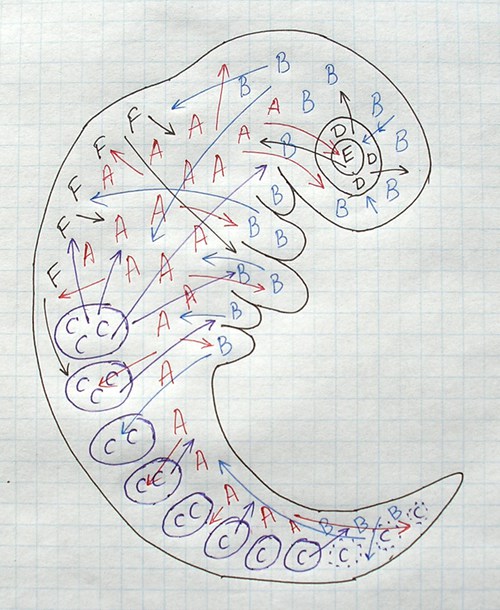
4.2. Pattern Formation.
In general this topic is already obvious, but we can repeat and clarify some specifics concerning development of different forms of bodies of organisms.
Basically it all may seem pretty fused, but the result of the development of a body is pretty exact and pretty stably reproducible, so we need to find out the basic specifics of this exactness in processes of formation of bodies of species.
Chemicals have some speed of distribution through intracellular liquid.
Diffusion through membranes takes much more time.
So the process of growth is usually pretty slow.
The next fact we already considered, it's gradual change of concentration of chemicals over cells, and it's most brightly expressed along the path between cells with extreme conditions, like edge cells and most internal cells.
And now most interesting point.
There's usually a lot of directions and space where stuff can happen.
And here are two defining things:
- Points, or sources of introduction and/or sustention of asymmetries (in distribution of molecules over cells). (optional)
- Redirection of the way of development of surrounding cells by differentiated one(s).
- [And slow speed of running of (chemical and diffusive) processes is implied.]
Let's consider simple example with homogeneity of outer influence and of internal distribution of changes.
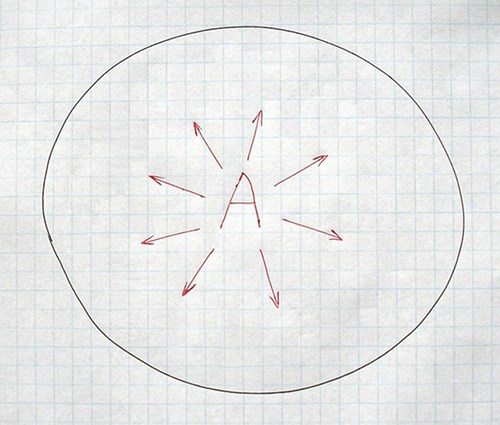 |
This is the beginning stage of development of embryo.
Central cells have higher concentration of some molecules, and more outer and edge cells have a little differing solutions, but cells are still of the same type.
Then (with growth, of flow of time) the difference increases and reaches some critical point, and (in this case) most outer cells are about to differentiate.
With some probability any cell near edge can differentiate.
From the other hand, less likely that solution is distributed absolutely equally (along the edge), and this tiny deviations (can) define the exact place of differentiation.
|
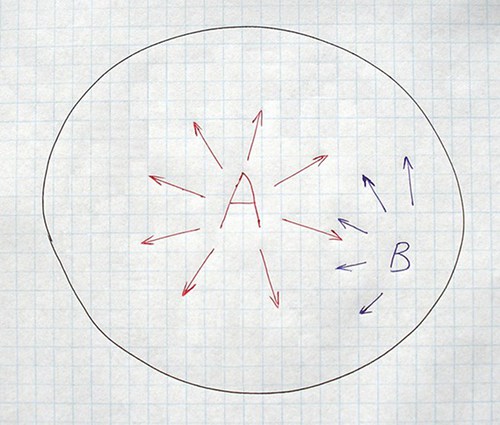 |
So in this picture we see that one random cell differentiated.
Processes, and outcomes of reactions change for this cell, and this differing solution is being distributed to other cells.
And, here we see basic crucial point, which is REDIRECTION of way OF DEVELOPMENT of SURROUNDING cells.
Previously, there was the solution of type A, with some gradient.
Now, around cell (or cells) B, there is the solution of type A+B.
The conditions (chemical background) around cell B now are different from the ones they were previously there.
And thus we see that now around cells of type B, the cells of type A cannot differentiate to cells of type B, because cells of type B changed conditions around, and for cells A to differentiate to cells B is required solution of type A, but now there's solution of type A+B.
Cell of type B can divide and grow, but around this new tissue cells of type B already do not appear.
(This does not mean that they cannot differentiate at all, but the type of new cells will be different, since concentrations of basic components already differ.)
But, beyond some radius around the cells of type B, concentration of the solution of type B may be negligible, or in some cases more correctly: may be still negligible, and cells of type B can (and after critical change of quality of solution, do) appear in other places.
|
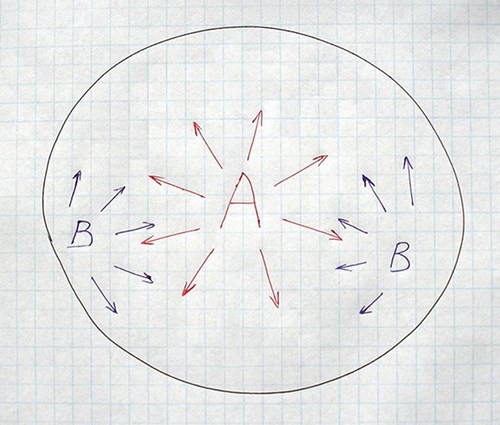 |
In other places of this organism appear cells of type B.
|
 |
Speed of (1) chemical processes, (2) of diffusion, and (3) random (or caused by outer influence) differences in concentrations between cells and areas
define the number of possible points of differentiation of cells of type A to cells of type B.
|
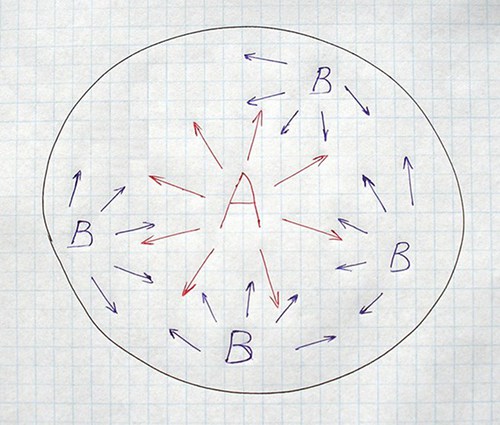 |
|
 |
And, there are no more places where differentiation to the cells of type B from the cells of type A can happen.
But the processes of internal changes and interaction with environment are continues.
Depending on quality of changes and molecules cells B produce
(and characteristics of their interactions with solution of type A, or with solution of all the other types of cells, which are present and reach areas with solution B and A+B)
new differentiations may start immediately, or after some critical threshold of raise of concentration of new components.
|
In the next image we see that further growth creates cells of type C in the area of presence of solution A+B,
and the cells which differentiate to type C could be of type A, or of type B, what's insignificant here.
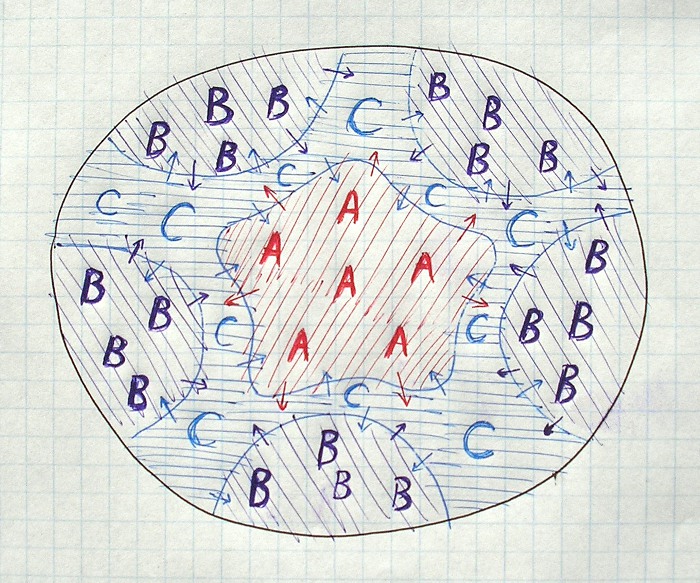 |
And... the process continues.
And this is how similar scenario of development may look for exact species, in this case starfish,
where we see that areas A, B and C divide further into sub areas (of cells of new types) according to the same basic mechanism, and those divide further,
and overall complex mutual influence of all areas complicates outcomes and construction:
|
Picture from the article "Starfish" at wikipedia.org:
|

|
Different types of cells (with differing structures and processes)
have differing rates of growth and other specifics, like rate of production and exchange of specific components.
AND THIS CAUSES appearance of all of the SPATIAL DIVERSITY of a body.
We can select the following key factors of formation of spatial form of a body:
- Size and rate of division of (each type of differentiated) cells.
- Firmness (or elasticity) of the structure of (each type of differentiated) cells.
- (and others)
So, for the starfish with the hypothetical scheme of beginning of growth we provided above,
(it actually may be different concerning beginning amount and proportion of differentiated areas, but basic principles of development are the same)
to start to grow the limbs it's enough to have the speed of growth of cells of type C higher than of B.
And, again:
this starfish appeared from basic cell (or cells) not because atoms and molecules were coming out of chromosomes,
but because environment supplied all this mass of (new) atoms and molecules and by the quality of this supplies directed exact extension of basic cells to multicellular organism,
and the process of extension was dependant on the whole structure of the basic cells.
And, another example with presence of outer sources of introduction of asymmetries.
In this case let there will be two of them:
- Gravitation (or some other upper constraint), which causes mass of cells to be laid along the ground,
and possibly vertical gradient of distribution of chemicals, (where lower layers may have more dense solution).
- Difference in quality (in this case gradual) of outer solution from different sides of embryo.
The number of black arrows from sides (in this picture) is proportional to the concentration of molecules in liquid (and, as a result to intensity of diffusion of molecules and atoms to and from environment).
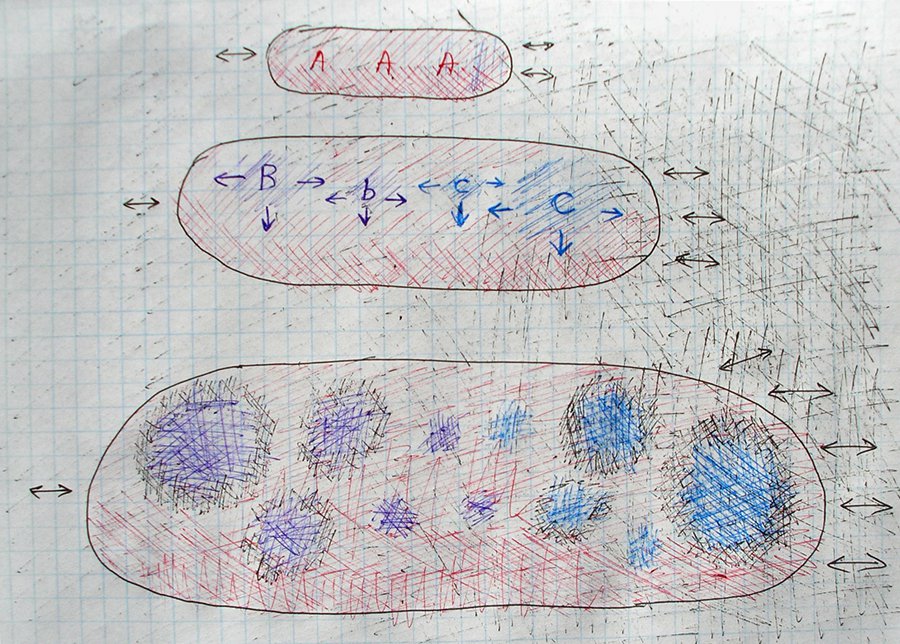
These three stages of development show gradual appearance of new types of differentiated cells.
Each type of solution (from different sides of embryo) promotes specific type of differentiation.
Black area around cells of type B and C are new types of cells (which may be different around cells B and C) which appear at third stage around areas with big enough concentration of new molecules, or different concentrations of already existing components.
A+B and A+C solutions create new differentiations.
And we can have a lot of bright examples of such rounded distribution of differentiated cells,
like for instance on the skin of this bright newt:
Though, more likely that in the case above the black border around red spots is pretty stable and appeared first (since there are a lot of small black spots on the skin of this newt) and the red area appeared inside of black during growth and expansion of black area.
The image of Snake-Mimicking Caterpillar below shows very similar schemes of development and differentiations (concerning color of the skin) as the newt above.
They both have small (black) spots over skin and rounded areas of different color with border, but caterpillar also has more complex pattern which consists of bordered pattern inside of bordered patter.
The second picture of caterpillar shows that small black dots are more like random deviations (or casual insignificant elements of evolutionary development), but the small black circles on the skin of newt have similar to considered above (pattern of rounded embryo) order of spatial distribution of differentiations with more or less similar distances which may correspond to initial pattern of redirection of differentiations at some surrounding distance by change of surrounding solution (by this changed/differentiated cell), and thus removal of exact conditions in surroundings for performing exactly the same differentiation.
Another thing to note about this pattern is that the big rounded bordered circles (for caterpillar it's more visible at the first picture) have more than one color (and corresponding differentiations), where newt for instance has more yellow and orange in the center of the pattern, then a little fused red border and then black border, what shows that boundaries between different types of cells had mix of two solutions of high concentration and (with growth of the area) created new differentiation(s).
And one more similarity about application of similar basic common schemes of patterning/development (in this case of traits of skin) of these species is that lower part of their bodies is of a little different color, what's characteristic for newt and second caterpillar, what may correspond to similar scheme of development of this trait at beginning stages.
Characteristics of growth of exact species depend on exact structure of their cells and exact environment.
In general case it may be enough to create one differentiated cell at any edge (or just non-central) point of uniform basic cells of embryo,
to define basic longitudinal axis, what actually already shows (by fade of diffusion of new differing molecules) the rest of the symmetries and directions of development (of exact species in exact environment),
where with non-uniform outer influence we may also see or predict the exact area(s) of these symmetries and positions of organs and limbs.
And, one more thing to note is that, obviously, these basic mechanisms are not very accurate and reliable,
and, as show observations, some disproportions or rough mistakes that appear during basic (and not basic) development are not rare, and constitute some percentage of outcomes (of development of bodies at different stages).
And... again, and again, and again, one central point of this article: caterpillar and newt are not (close) relatives, and all this stuff is not "encoded" in one or few of the molecules of a cell, and this all is a result of complex interactions of basic (a little varying but basically) uniform components, and the basic processes of body formation are very similar for species which share similar basic elemental base (what we considered above at basic schematic level), and the process of growth is also not encoded in cells, but defined by environment which extends, or replicates molecules of cells by provisioning exact components and thus directing exact replications of molecules (and as a result of cells). And all atoms of all molecules are active and functional, and the resulting complexity of traits and behaviour is defined by complex interaction of all of the molecules.
4.3. Aging.
There are several theories of aging.
One (or several) of them are "genetic", pretty complex ones, let's cover them pretty substantially in the second part of this sentence: they state there are "genes" responsible for aging, and corresponding to that "genes" molecules remain inactive (or non-functional) for some period, and later become active, and start to function physically and cause aging.
We considered such stuff pretty extensively above,
and some of the other theories are based on the fact that cumulation of errors in replication of cells leads to senescence,
and there's also a lot of nice stuff, which show dependence of length of life on conditions of evolutionary selection.
The errors in organisms happen with some probability, as we considered this subject in mutations,
but the matter is that if to take a look at actual number of cells in organisms, and the amount of mistakes required to make all of the body such degrading, it's obvious that rate of mistakes in cells had to be unbelievably high, and with such level of instability general life and evolutionary biological development would be not very possible.
The second point here is that errors in cells are basically mutations, and thus the way of physiological changes during aging would be similar for different individuals with low probability.
It's like to compare influence of development of different mortal diseases, this how would look in general senescence if errors in cells were the main cause.
The third point about this approach to describing senescence is that errors are probabilistic, and thus there could be pretty wide distribution of length of life and start and duration of senescence, if errors were the main defining force.
What we observe in reality is that aging is very stably reproducible in both respects: (1) the way of running of changes, and (2) similar time spans characteristic for this processes (for population).
So, the basic reason of aging are not errors.
There's stuff based on this concept which is pretty widely accepted, like for instance this one (the exact phrase below is taken from wikipedia.org):
"In humans and other animals, cellular senescence has been attributed to the shortening of telomeres with each cell cycle; when telomeres become too short, the cells die. The length of telomeres is therefore the "molecular clock," predicted by Hayflick."
which is also wrong (since this is error in development) and this exact case we will mention further in this chapter.
To put description of Aging short,
- the reason of aging for exact individual is:
non-coordination of pace of development and of functionality of parts of a body beyond reproductive period,
- and from point of evolutionary development of this trait the reason is:
absence of necessity to carry out selection in this respect, or beyond reproductive period.
Organism grows, complexity of the structure of organism raises, complexity of mutual influences raises.
These constant changes mutually influence different parts of organism.
Appear new tissues, new organs....
and goes process of constant general transformation.
Some processes remain pretty stable and almost don't change, some change significantly, appear new components and affect others, which in turn affect indirectly other components, etc...
At some point it comes to such state of mutual influence of components, where growth of basic structural tissues is reduced, or for some parts stopped, because of direct and indirect influence of new changes.
This was just one of many other scenarios of development, which turned out to be pretty successful from point of survival.
As we know there were pretty big animals, and there are pretty big animals, like whales, and there's high probability that there were (and probably are) species which do not stop to grow in size, either at all or continue to grow after reaching reproductive period,
but not much of them survived (at least animals). (Though this paragraph did not concern aging.)
The processes, tissues and their characteristics constantly change, some appear, some become more intense, some less intense,
and the fact is that:
to prevent this complex machinery from further changes and to keep it in some perfect state of some point of development would be pretty hard (and almost impossible) task (for complex species with current preferences in forms), even if natural selection would care.
There are observations which show that predators usually live longer than prey, like for instance when they are put in the zoo and their average lifetime measured.
Species which do not have (at all or much) of predators, for instance seabirds, have longer life.
These are conditions which cause the selection to take into account this parameter.
Pretty interesting case are turtles, who have longer period of life, because of specifics of selection which facilitate selection of long living organisms.
Adult turtles are extremely protected.
Young turtles are extremely unprotected: they don't have yet firm protective cover or protection of adult turtles.
They born at land, have to travel to see, and then survive there for some beginning period,
and they may be massively attacked by predators like crabs, and possibly by a lot of others.
Thus, when few of the samples succeed to survive, they already do not catch young (or short living) individuals, so the natural selection in this case naturally was selecting long living samples.
Crocodiles or/and alligators are pretty long living, since they eat most of their own offspring (I heard number 99% in some tv show about animals), and thus have a little similar conditions of selection to turtles have.
But, anyway, as we see, for complex species it's almost impossible to prolong life significantly because of complexity of organisms.
From the other side, for very simple and relatively simple organisms, the factors we rejected in general at the beginning of this chapter (errors in cells) for this case are one of main reasons of death, besides predators and accidents.
And, another pretty interesting point concerning evolutionary development, mutations and life in general.
New organism grows up, complicates, there may happen a lot random negligible or not negligible mutations... and the process goes... and possible number of these deviations or error increases, organism a kind of undergoes deterioration... and blah-blah-blah...... but,
let's rewind the process back, to the first cell.
Pretty often it is assumed that this is a kind of perfect etalon of a cell, which later eventually gets spoiled.
But this cell did not appear out of nowhere.
It came from parent organism.
And in parent organism it did not exist in separate perfect conditions.
It came through series of divisions before became gametal cell. Pretty long series of divisions.
And... the cell which born that one gametal cell and its parents, came to its parents from previous parents.
And... that cell came from their ancestors...
And... that cell of ancestors of ancestors... of ancestors... came from... monkeys ))
There was no break. One continues line of division, and of development.
And... back to reptiles.... and back to fish... and... back to unicellular organism...
And... that organism appeared from more simple organism... and that from more simple...
So far we have proven that my farthest direct biological ancestor is..... primitive molecule ))
May seem funny, but it's true.
There was one continues line of existence of complicating and dividing molecular pattern, which complicated (because of random mutations) to cell, then to primitive multicellular organism, then to fish, to reptile, to mammal, to human.
And this ancestor is common for all individuals of a species from point of appearance of a species and backward.
So, now can you tell the age of existence of any cell of any organism.
Continues root goes back to the very first molecule which undergone string of complications and become that organism.
Each cell (or simpler organism) can be traced back through the string of replications and complications (or in this case simplifications) to very first basic molecule.
Some atoms of a cell (or simpler organism) during division come to one cell, some to other, it's probabilistic.
And, so, there's a probability (though very tiny) that you posses one, or a few or more of the very first exact atoms of a molecule which started biological evolution (along our line of development) billions years ago, a physical part of your first ancestor ))
And we already know, that it was basically biologically full-fledged organism, but of a primitive general complexity.
And the same from the beginning.
Atoms and molecules interact and create random compounds.
These more complex molecules interact with other molecules and (a) create new compounds, more complex or more simple, or (b) with some probability replicate.
And at some (or all) of these points begins biological evolution.
And now let's observe the path of this developing molecule.
It exists as primitive molecule and replicates. Then as set of molecules. Then as simple cell.
This simple cell replicates, sometimes changes and this new changed cell continues life and replications.
There's one particularity about this path. This is successful path of development.
A lot of paths become distinct.
If we observe some organism, it means that it has already taken all of the path of development along successful outcomes, (otherwise it would not exist).
At some point of its changes it happens to replicate to multicellular organism.
Now, besides becoming part of successful individual representative of a species,
this cell also has to take successful path of divisions inside of this exact organism to travel to the place where gametal cells appear, and become one of it, and then start new organism.
This is the way for the cell to survive.
It has to come along all of the way of replications from first cell of an organism (from that exact pattern), to gametal cell (PROBABLY STILL CARRYING IN ITSELF SOME OF THE VERY FIRST, ORIGINAL ATOMS which started this line of development), and become first, or one of first cells of new organism.
Otherwise it will die.
So now for particular cell of multicellular organism to survive the task is at least twice as complex,
since it (1) has to be passed to successful sample, or organism, which will survive and create (or participate in creation of) new organism, and then (2) travel by the path of replications exactly to the place where gametal cells are being created, and become one of them, and then (3) actually start new organism.
Again, any cell we observe around had luck to come along the successful way, otherwise we would not observe it.
Most of our (and of all of the cells around) are destined to die, and only tiny amount of them will become new, or part of a cell of new organism, thus surviving along its path of development.
Life of cells... )
Cells don't have such complex stuff like mind or consciousness, and they just go from one organism to another, if have luck,
but the fact remains: each unicellular or pre-cellular organism or any cell of multicellular organism has period of life equal to the length of ALL biological evolution for its line of development,
and:
- it was either replicated from that exact (changing) pattern along the way, or
- it was replicated from that exact (changing) pattern along the way + still carries some of the original atoms,
and thus may be not only directly physically replicated, or prolonged from that ancestor organism,
but also still may physically contain exactly that same cell, or it's part with some additional complications.
And, if to remind that assumption about:
"In humans and other animals, cellular senescence has been attributed to the shortening of telomeres with each cell cycle; when telomeres become too short, the cells die. The length of telomeres is therefore the "molecular clock," predicted by Hayflick."
we give the answer No, in general case telomeres (if such thing exists) do not get shortened with each cell cycle, and the length of life span of each cell is equal exactly to the length of biological evolution along the line of development of that cell, or of an organism it is in.
Despite significant probability of mutations, vast majority of cells do not experience them at all during life in exact individual organism, (what we discussed a little at the beginning of this chapter).
Another thing to note about this is that despite the fact that for each cell the root can be traced back to the beginning of evolution, for some cells the roots periodically (or pretty often: at each point of division) are joined,
and initially there's one primitive ancestor in form of very primitive organism (= in form molecule, or several molecules), which gave birth to the rest of organisms, by division, or by division with complication.
Since this chapter about Aging, let's consider one main characteristic of this post-reproductive period of existence of complex organisms.
There's one pretty good analogy of the process of aging in the area of electronics.
Microprocessor has a set of documented features (and usually very complex structure), or commands and some behaviour as reaction on that set of designed commands.
If something different is supplied to microprocessor, not designed by designers of microprocessor, then the state and further behaviour of the microprocessor is said to be "undefined".
This is exactly what happens with complex organisms after they pass reproductive stage.
Further behaviour of this very complex machinery is undefined.
All of the process of development from one cell up creates different blocks (differentiated tissues and organs) with own pace and specifics of operation, they develop, mutually influence each other and there are constant changes in form and functioning of organism,
and after reproductive period passes, all of these parts continue to function along own lines of development with own pace and mutually influence and change each other,
but now organisms are left alone with this machinery,
and the fact is that most of the organisms in wild nature (probably with not common exceptions) actually did not know what is senescence and how it may look.
Our problem of senescence is mostly something new for biological evolution, and (such abstract essence as) Natural Selection (and most of the species) did not even know how this period would look like, and the word "undefined" is very suitable.
But, the fact that we're left alone with this problem does not mean it should not, or cannot be (at least partially, or for some period) solved.
By making large amount of calculations this growing disbalance in functioning of parts of a body can be pretty efficiently corrected by artificial chemicals, and thus life significantly prolonged.
4.4. Characteristics of Development of Embryo of Complex Species.
After all of the discussions about biological evolution, this chapter already should be obvious as it is based on that stuff, and especially on the information from previous chapter, but let's repeat it once again.
At first embryo of mammal (or other similar complex species) may look like fish with something what distantly reminds gills, then some traits of other previous species, then of other....
And, as we already know,
these are not detached abstractions,
and this is the path of life and development that basic cell of an embryo ACTUALLY PASSED previously.
That redundant traits of a structure of a cell are scars of REAL PAST battles IT CAME THROUGH )
It could happen that along some period of development that cell could gradually substitute all of the traits of previous forms by small portions of other changes and get very different traits (and for sure there were such organisms who unintentionally, driven by random mutations, tried to do this, and a lot of them did not survive), but it did not happen (at least for us), and the reasons are the following:
- To consume food organism: (a) has to have similar elemental, or molecular base to effectively use similar basic components of a food, and (b) it has to keep some of the organs of at higher level to decomposition the food to basic components.
- To survive and pass natural selection organism has to keep organism tools adequate for protection and getting food,
and this did not allow to deviate far from effective stuff used in mainstream.
- After growing for pretty long cellular structure very severely restrict possibility of quick deviation from this gained complexity.
- (and, maybe something else...)
And we see that the structure of a cell after being extended (in specific environment by provision of specific components) to these stages of embryo already does not represent very exact properties of that species,
but it's hard to make basic substantial changes, and it did not happen.
So, the extension of a cell to embryo and further shows some accumulated basic features (along the way of its continues life and development) which are very hard to get rid of.
And to be exact from architectural point of building complex construction of this kind, it's like you start to build skeleton of a building not in optimal way which repeats the shape of the resulting building (because you actually by that time may not know exact final optimal shape, since surrounding factors constantly change), but start from some basic (strange) form and then extend it to desirable form, while testing it against environmental conditions.
And the shape of a fish (represented at the beginning stage of development of embryo of mammals) is this internal part of general framework which already cannot be easily thrown away,
since all of the components in cell (and further in developing body) work by mutual influence, and all of these mutual influences were complicated/developed (by evolution) with that framework of a fish (and of other traits characteristic to later stages) taken into account,
and now, to remove that fish from the structure of a cell,
ALL INTERACTIONs of ALL COMPONENTS of a cell have to be recalculated and all this stuff (properties and functionality of resulting species) has to be redesigned almost from the ground without presence of INTERACTING components of that fish,
which introduced itself into the design at the beginning stage of the development,
and (again:) EVOLUTION MADE ALL OF THE FURTHER (after fish) COMPLICATIONS TAKING INTO ACCOUNT presence OF THAT (active, or functioning and interacting) BASIC FRAMEWORK OF A FISH.
If to simply remove the molecules which left from fish, the whole construction of a cell will be in "undefined" state, since that parts of a fish interacted with, and affected the rest of the parts, and now the rest of the parts without that influence (of removed parts of fish) will behave and develop differently, not to human organism.
(Now you should feel in more details the difference between "genetics" and reality, and how actually all these biological stuff in reality works and how it appeared. It's not acceptable for correct knowledge to ignore the complexity of observable interactions.)
The structure of complex species which have a lot of redundancy, like mammals, could be rebuilt to be much more optimal with similar resulting shape and functions, but for biological evolution it would require very much of time, to make such substantial redesign,
most probably much more than to carry out the development from the beginning.
The first successful molecules were replicating and sometimes complicating, then became more complex organisms, then the cell started to travel over organisms, and since it came to this time, it means that it succeeded to pass through all of these successful paths inside of organisms it came through, but before it did complicated it came through unbelievable amount times through bodies of fish and of other higher animals, since it had to wait for mutation to happen exactly inside of it.
From point of complex species, like for instance human, all roots come to one root at first organism that made this species and then backward goes only one successful path of development,
but existence of this complex life along that path of development did never stop, and all of the cells of all organisms of all species have this line of direct replications backward, and some random cells with some (very very low, but, still non-zero) probability have come along all of this line not only by direct replication from patterns along the line, but partially directly with some of its atoms, through all or part of the whole developmental line.
4.5. Regeneration.
Regeneration, or simply growth, is restoration of an organism (its extension by environment) to some specific state.
We talked about growth, where at some point mutual influence of components (of complexity at that stage) change the overall behaviour of components in the way, that increase in size may stop.
If to rewind the process a little back, when some of the parts did not appear (at all or in all of their further complexity),
we may consider this previous state as instable compared to the further state,
and to come to more stable state of the interacting components it undergoes changes (represented as growth).
Now if organism loses its part, from point of completion of general interactions it becomes not optimal, and may tend to restore itself to more optimal, or more stable state.
Some (distant) analogy could be the following:
It's like to fill plate with water, and then to put glass, or some other object into the water.
Now this substituted volume of water can be considered as lost part of an organism.
And then if to remove the glass (quickly) the water can actually have this space as void (the state of organism with lost part)
and the processes will run in the directions to form more optimal general interactions and water will fill this empty space.
In terms of mechanisms of development of an organism,
the driving force to develop something in a cell is mostly (if to ignore in current context propagation of chemical interactions through membrane from outer cells and in this way influence by other cells of processes in this cell at some points along membrane, what is secondary by significance to diffusion of chemicals)
INTERNAL and NEAREST SURROUNDING CHEMICAL BACKGROUND,
or quality of the solution.
And, the exact fact is the following:
if organism loses its part, then at edge tissues of the missing part solution becomes different, since rates and diffusions of diffusion change,
and, thus, chemical background of a cell becomes different.
If an organism had this part and lost it, then this change of quality of solution (of remaining, and especially of edge cells) may cause changes in (1) the structure of (some) cells and/or (2) in characteristics of running of their processes.
Basically, everything is the same as we considered above (in both, chemistry and biology):
change in complex interactions causes redistribution of these interactions (and their mutual influences).
There is no universal high level rule of behaviour of an organism and especially of the edge tissues after loss of a part of an organism,
except the dependency on complexity, where more simple organisms would regenerate parts more likely.
In general case it depends on exact structures and other specifics.
In complex organisms cells undergo strings of transformations, called differentiations, and in general case to have regeneration of complex part of an organism, all of the organism should be in the state of development, when growth of that part was natural.
So, the general state (and exact states of differentiation of cells) have to be transitioned back to have that conditions of development.
Let's consider at this point newts and salamanders.
They have outstanding abilities for regeneration, and can restore limbs, most of an eye, lungs, and other (but not very basic and crucial) parts.
And below is excellent picture of newts for this subject.
The reason of great abilities of regeneration of newts are actually already obvious:
they are very primitive (compared to more complex species) and this provides ease of basic reconstructions.
And some of the known facts about newts, and from the picture above:
- They have very bad sight, and (at least some of them) can distinguish only moving prey.
(What clearly implies that they have very poorly structurally developed eyes).
- Limbs are yet not very well functional, as we see by the way they move above,
and fingers are like in embryo state.
- and so on..
This relative primitivity at basic level has the following property:
difference between differentiated cells should not be big.
This, in turn, provides two main advantages required for effective (natural) regeneration:
- The difference of concentrations of chemicals between young and adult stages (in general over organism and in exact places) is not big,
- ease of carrying out required transformations to change differentiation of edge cells (either through transitioning to more basic and less differentiated stage first, or directly by making both changes in parallel),
so, (because of poorly developed traits and small differentiation) it does not have to return far back to have the conditions of active growth with corresponding general distribution of exact concentration of exact chemicals (since it all changed not much) required to carry out intensive growth, and it's easy for cells to undergo small transformations.
And key point to remember here is that all of the details of these small exact fits of processes and structures (and as result ease of structural transitions) is not uniform characteristic that correlates with complexity of a structure.
This exact fitness of components, forms and reactions which provides such great abilities for regeneration was very thoroughly selected by evolution over long period of development and selection.
In complex species, like human, natural effective regeneration is almost impossible because of high complexity of an organism, what provided highly developed organs,
but at the same time it's almost impossible for such complex machinery to make big maneuvers in changing significantly chemical background in tissue specifically for regeneration of its part, since a lot of the interconnected complexity in organism cannot be reverted back easily, and such means were not developed.
So, basically, at adult stage complex species usually have growth or restoration of parts, which not require involvement of processes which were taking part at previous stages of development, since such conditions in such complex and interconnected organism in most cases cannot be restored (since a lot of parts should take exact path of development several or many steps back), and cells of required intermediate stages of differentiation (at current moment) may not exist already (as that parts could differentiate to something different, by reverse influence of newly developed parts).
It was found long ago, that for regenerative purposes in many cases very well fit non-differentiated cells of an embryo.
But basically it is very limited special case.
Direct usage of basic non-differentiated cells is far far oversimplified approach, and actually in most of the cases (for carrying out, or correcting some processes of high precision) it can be plain not applicable, since in most cases is required not the very basic non-differentiated cell, but a cell which already has some specific required level of changes, (and thus cell with difference in changes backward along the path of differentiations may be as inapplicable as any other cell with significant changes in structure).
To be more exact chemically: you can perform string reactions to have something more complex, but there's low probability that this exact complex structure will appear if you will just mix at one moment all of these components (which could give something special if applied in exact order with exact conditions of reactions), or the result will be far different.
And this is actually what can happen with basic non-differentiated cell if it is put to highly differentiated environment, since all of those cells obtained that exact complexity by going through chain of reactions and gradually making exact changes in exact order in exact environment.
And a little more about the role of evolution.
There was a compromise between preservation of regenerative abilities and complications which provide other useful for survival features.
And the goal, or driving force of these processes was positive statistics of overall survival of population or of species, as we already considered this point, and the rest did not interest natural selection.
Basic (molecular) behaviour of bodies of species beyond necessity to survive in a lot of respects is "undefined".
It's not that it's impossible at all to do such things, it's just that during earthbound evolution of complex species in points of compromises concerning regeneration vs complexity, accents were shifted towards complexity, as in this environment it provided better abilities to survive to species.
But, as in the case with aging, or resisting to ongoing mutations, or to other problems of biological organisms,
most of these abilities can be obtained (or the direction of development of body can be changed) in artificial way,
by changing influence of environment, since body of exact construction during interaction with this exact environment cannot fix itself,
or, to be more exact:
by calculating all of this stuff and making artificial chemicals, tools and processes for correction of development of a body from outside.
4.6. Optimality of organisms.
As we see, more simple organisms at the beginning of evolution have very direct use of (mostly) all of the structural decisions embodied in their basic structure, while later ones (because of considered above factors to preserve inter-operability with existent surrounding stuff) have some level of redundancy,
and, as the main evolutionary parameters, which may give (rough quick) approximation of the amount of redundancy we can consider correlation of such factors like complexity of a structure, amount of time lived in specific environment with specific level of complexity of basic structure (which required preservation of some of the previous skills), amount of time lived in separation from some of that conditions, etc,
what actually describes the time evolution was given to develop organism in specific direction and defines abilities of exact cellular structure to undergo changes of specific complexity in specific conditions,
but,
most of the information that was planned to go into this chapter is already covered,
and the next one is
4.7. Chromosomes.
So, what's the role of the chromosomes is then...
Chromosomes consist of basic components (of a little variable types) joined together in a long string and then condensed, probably to occupy space more optimally.
Such long string, called DNA, (during life of a cell) copies itself to smaller parts,
and those smaller parts replicate themselves to smaller,
and those smaller arrays replicate and produce basic molecules to build organism and support other functions.
Obviously, it requires production of a lot of basic structural material (from outer supplies) in cells to replicate them in short period to large multicellular organism, and also to support other processes characteristic for biological life,
so there's a need in large amount of basic source materials,
and wide arrays of DNA are main units of production of these basic materials, (which may be located not only in chromosomes but also in other parts of a cell).
One basic property of DNA we already sufficiently considered above:
they represent only themselves and don't hold information to build organism or other its parts, except themselves.
As we already know, the complexity of possible resulting diversity of forms and behaviour of adult organism is in some proportion to complexity of its basic cell, since the more complex is the basic structure, the more abilities for complication has environment while extending it (to adult organism), and by changing a little some parts during the process of extension, (and the resulting complexity may grow very quickly).
The chromosomes are among the most uniform components of a cell (especially if to consider the amount of atoms per component)
and, thus, have one of the least significant impact on formation of structural complexity of an organism.
The only significant thing which can be attributed to chromosomes (in the respect of defining structural complexity) is (maybe partial) definition of sex (in some of the species),
where females have two chromosomes of form XX, and males have corresponding chromosomes of form XY.
Where chromosomes X and Y, besides differing in shape, also significantly differ in size.
BUT...
we should do very clear clarification here:
This is BRIGHT STRUCTURAL difference
- which is above (or insensitive to) the basic level of consideration of permutations inside of uniform stings of DNA,
(to what is bound all of that "genetic" stuff).
Chromosomes at a level of structural components (with varying spatial forms) of a cell,
should be CLEARLY distinguished from the area of consideration of "genetics", which concerns permutations of basic components of uniformly aligned strings of DNA.
So, chromosomes have some limited number of varying basic components, which through series of replications are copied to basic building (and other) blocks which (partially) supply growth and other processes of a cell.
Because of these random permutations of basic components in the arrays of DNA, the resulting building (or of other functional type) basic components may also vary.
And this is all of the influence of these permutations.
We can draw the following analogy:
the structure of a cell is a function, and these variable basic components are parameters.
Now, how significantly defining these permutations can be.
It can be very well described in the following analogy.
The structure of a cell is the design of a building, which is used to replicate, or build the building.
The basic blocks are (more or less uniform) bricks.
If the breaks perfectly fit to the once required by design and the process of reproduction is perfect, then we have exact copy of the building.
Now if the bricks can vary in different characteristics,
we will have deviations from the design in new construction.
If the bricks are a little bigger, the building will be a little stretched,
if the color is a little different, the color of new building will be a little different,
if the bricks have a little different height of opposite sides, we will have incline of a building from one side, or random small changes in size over the whole construction.
If the bricks are too badly fitted, or too defective, the building will collapse,
or in the words of evolution: will not survive.
In words of function: if supplied parameters change too drastically, then they will lead the function beyond the restrictions of possible support of life.
In exact case it all depends on characteristics of general evolutionary processes, on how thoroughly selection was carried out.
And, that heap of bricks, the building is to be built from, are the arrays of DNA.
They don't represent the design of the future building, and only themselves.
The same heap of bricks may be used to build a barn, or a very nice house.
To build something from them, the design, or the structure of this something is required.
In a lot of cases these basic varying components are interchangeable, and the usage of these a little differing blocks in specific place of each organism actually defines these (small) differences, like color, height, etc.
And the usage, or selection of exact component for exact place (from variable range of components suitable for this place) is defined by availability of components of specific type in specific place at specific stage of development of organism.
This stuff is statistical.
There is no 3:1 distribution of traits,
and Mendel in his original experiments did not have such distributions either.
He had 3:1 (or some other numbers for exact considered trait of exact species) ON AVERAGE.
In some cases there may be much larger concentration of building blocks of one type, and we observe some consistent color or other characteristic, but there may be equal amount of differing basic blocks and distribution of exact trait over the tissue may constantly vary (at least during some stage of development with equal amount of basic building components preserved at this period),
like in the picture below:
And, again ))
there are none of inactive components, they all are active, but differ, and because of this we see different representations.
So, let's make the conclusions about importance of influence of permutations inside of DNA:
- For extreme cases of un-fitness of basic components (which yet were not removed by natural selection), or in case of rough errors, influence of permutations of parts of DNA may be vital.
- For pretty stable outcomes, permutations of (and inside of) basic components define minor traits of an organism.
- And, from point of consideration of basic principles of structural (relatively stable) development of organisms, these permutations are almost completely negligible.
It's pretty funny )), since the role, or significance of permutations inside of DNA in reality (concerning influence of formation of structural complexity) is almost diametrically opposite to what it is believed in modern science,
and in most cases is almost completely negligible, compared to importance of (spatial) structural complexity of a cell.
DNA is just a uniform array of more or less uniform bricks,
and to build a building, the whole design (the whole structure) is required
(together with specific environment).
Another thing, which does not correlate with modern "genetic" views,
but very well correlates with correct views and evolution, is the following:
amount and size of DNA per species.
According to "genome" size, rice should build an organism at least twice as complex as human,
where in reality the amount and size of generators of basic blocks is in proportion to need of these basic blocks (or in such structural blocks like chromosomes),
and evolution adjusts size and amount of DNA according to required rate of growth and activities, and to similar parameters,
and the complexity of an organism correlates with (structural) complexity of the whole basic cell.
And, one more citation...
|
Citation from the article "Evolutionary developmental biology" at wikipedia.org:
|

[24] Gerhart, John; Kirschner, Marc (1997). Cells, Embryos and Evolution. Blackwell Science. ISBN 978-0865425743.
|
5. Life.
Let's give the definition of life, one of the most basic and uniform, applicable to anything in the universe and to the universe itself.
Life is a period of consistency of the essence of representation and/or processes.
Note:
The essence (or main, or the most significant part) of representation or processes of something is not obliged to be uniform and is relative to perception of observer.
(One can choose and consider life of different aspects of something.)
6. Comparison to Modern Science.
There have been made big efforts towards explanation of the stuff we considered in this article, as well as concerning a lot of other things about the universe,
including theories about formation of bodies biological organisms.
One of the approaches has one of the very correct basic points, together with incorrect stuff which blocked development of the whole approach,
and another approach (of widely known) is based on application of reaction-diffusion systems to pattern formation, which looks to be the major accepted direction in modern science,
but it was a big mistake to go this way, as application of such mathematical models in this context basically is plain inadequate, and we'll consider this approach first of these two.
But before we consider them, we should take a look at one pretty interesting point about basic modern fundamental sciences,
what will shad light a little on the flaws at basic sciences, which in turn caused a lot of mistakes in more high-level areas.
6.1. Inapplicability of Modern Fundamental Sciences.
There's one very bright example and let's start from considering it.
Replication of DNA according to modern science.
As we see, it differs very significantly from reality based on correct chemistry, as we considered it above in corresponding chapter,
and most or all of the components except the DNA itself should not exist in cells or at least do not do the stuff shown at the picture above during replication of DNA.
But this is only beginning,
and at the next stages of replications of DNA to proteins ribosomes get involved, and stuff becomes much more complex,
and the fact is that pretty much of components of a cell, including one of the most complex components of a cell like ribosome are used to replicate DNA to proteins.
Now here becomes obvious one basic unsolvable inconsistency, which actually roots down to more fundamental problems of fundamental theoretical sciences, (and which was shown in scientific literature long ago).
And the fact is that:
- pretty much of the complexity of a cell is used to replicate DNA and DNA to proteins, actually one of the most primitive and straightforward structures of a cell,
- while
- there's no description of replication of other parts of a cell,
- and actually cannot be,
because the rest of components structurally are much more complex and to replicate them it would require stuff which instantly and largely exceeds complexity of a cell.
And the basic fundamental problem of fundamental sciences, like physics (and derivative chemistry) is the following:
If there's no description of observable complexity of reality at the basis (at least to some level of acceptable completion),
then to model reality by these incomplete basic essences, you need to use more of them (with different properties) than the actual amount of them is used in reality in correspondent phenomenon.
To describe behaviour of one or of a few atoms, using modern physics and chemistry may require involvement of dozens or more of atoms to build molecule with the same functionality,
and this, obviously, is plain inadequate approach, since you simply cannot do anything (even relatively simple) even in far approximation correlating with reality,
what we actually saw on the example of replication of one of most structurally primitive and straightforward parts of a cell (DNA), and to replicate using this approach the whole cell, or even ribosomes (and other replicating machines used to replicate DNA),
it would require replicating machines of much larger complexity than the whole cell.
The problems of reconstruction of at least a little complex molecules lie in absence of completion of description of interactions of essences at the level of atom,
what obliges to use (during description of reality) more atoms than there are actually used in corresponding stuff in reality,
and thus nearly at the very beginning of description one is destined to run (in the description) far away from reality.
Now's 2010, and science still can't advance beyond understanding of few of small proteins.
And it will not advance further, until more correct basic means for description arise.
Needless to say that stuff of modern science like replication of DNA and other of complexity beyond small molecules is based on almost pure guesses.
So, the problem is actually not of biology, but of physics and chemistry,
since if there are no principle abilities to build description of reality,
then it's almost impossible to do it in adequate way.
But in this example of replication of DNA, not having correct description was only part of the problem,
since assigning to other components of a cell functionality which they do not have, and where they actually do something different, unbelievably twists reality further,
and so forth, and it does not make much sense to build and use knowledge based on such basis.
And it concerns not only this exact case.
With oversimplified stuff, like currently used in chemistry, it's impossible to understand most of the biology, and most of the evolutionary processes, especially beginning of biological life, and similar.
On the other hand, usage of (even approximate high-level) correct descriptions of chemical interactions, or of correct basis of physical reality at a level required for this area,
we were able to build and see all of the basic accordance and completion, from the very beginning, in any basic conceptual particularity of biological processes, together with all of the specifics of biological evolutionary development.
6.2. Pattern Formation Based on Reaction-Diffusion Systems.
It is actually pretty hard to find similarities between one (or few) of relatively primitive equations (intended to be applied to almost uniform environment) and the complexity of a cell and its growth, to tie them together in some way.
Let's just show one basic point (what is ignorance of completion of reality, what we also thoroughly considered in one of the previous articles) and cut it down.
Basically, the essence of correct modeling of growth (and pattern formation) or most of other processes of biological organisms include the following (and we mentioned it for several times already above):
Correct results =
- correct description of chemical interactions
- + basic configuration of atoms and molecules of a cell or cells (with ordinary earthbound biological environment implied)
- + massive computations.
Everywhere over the cell may be different combinations of exact molecules which form different components with different characteristics, (what constitutes beginning molecular configuration of a cell), different components have different rates and characteristics of reactions, and if more than one cell is involved, the characteristics of diffusion inside of intracellular liquid between components are very different compared to inter-cellular diffusion, and as interaction proceeds, these basic parameters of components may change, since structure of components may change, and these changes are not uniform across all of the cells, but depend on exact configuration of exact cell, etc.
Now, what is reaction-diffusion system: one or few of equations.
It covers (almost) none of the reality in the object under consideration.
The direct analogy is if one would say that it's possible to restore complex design of construction of a building, with all of the specifics and particularities, (only) by few aggregate parameters like: (a) the overall volume occupied by the building and (b) total mass of all of the different components used to construct this building.
6.3. Pattern Formation Based on Positioning Information.
This one is pretty interesting.
It correctly covered few of the basic points: position of a cell inside of a group of cells defines its differentiation according to concentration of chemicals in that area.
But it has some minor flaws, and one major: conformance to "genetics".
Looks like one of the major obstacles for Lewis Wolpert in developing it correctly in completion, was severe lack of diversity of theoretical approaches,
where he did not go (or almost did not go) any further beyond the poor set of available experimental data.
As a result, there was not developed completion of understanding of correct dynamics of growth of organisms and gaps were filled by heavy usage of "genetic" concepts,
(and particularly: inhibition and activation of processes directly based on active and inactive "genes" instead of complication of solution and structures and change of directions of development in different areas),
what of course was vital and strictly blocked development of his model in correct direction.
Reference to Positioning Information ideally had to be put somewhere at the beginning of explanation of growth, but I came across this stuff after I've written the basis of this article, so I put it in chronological order.
7. Conclusion.
As we see,
influence of "genetics" on science (at current stage of development) is unbelievably negative.
It led up biology to dead dead end, and left with no means for advance.
Practically any question or assumption, especially fundamental one, is forwarded in completely wrong direction, and is being equipped with basic rules which almost do not correlate with physical reality and strongly prohibit any significant advance.
It's firm blocker for development of biology and areas dependent on it.
It's not that there's something wrong exactly with this source of citing.
This is representation of generally accepted knowledge, and any other area which concerns this subject will show similar general views.
|
Citation from the article "Evolution" at wikipedia.org:
|

|
This and previous article have the answers to these questions, including the once which show that it's not about "gene pool" but about "molecule pool" (and this pool is not limited to only molecules residing in chromosomes), and the whole structure of a cell together with the environment define development of an organism.
People will still be solving mysteries of chemistry, biological evolution and life probably for hundreds or thousands of years, and you already know most of the basic answers for this area )
"Modern developmental biology studies the genetic control of cell growth...."
Poor fellows.... nearly completely wrong direction.
All atoms are basically similar. There are no inactive atoms. There are no atoms which hold inside of themselves other atoms or part of a cell (except themselves). The structure of a cell is defined by the structure of a cell, and not by its part. From point of consideration of formation of structural and functional diversity of a body, DNA/"genes" are ("with a few exceptions") either least significant, or negligible.
As you see,
- when we were talking (in introduction) about possibility of biology becoming exact science, with all of the predictability of the results and control over biological processes,
it wasn't a joke (as the rest of information at this site).
- and it all can be implemented and benefited pretty quickly,
and if to compare the time of implementation of all the correct stuff to predictions of development of science made by modern science,
then we can say, that all this can be implemented and benefited really unbelievably quickly.
Will science remain in stone age for thousands of years more, or will it stand on the road to truth and perfection,
it's up to you.
Copyright(c) 2010 Sergey Bilyk.
Published on October 24, 2010.
License: public domain.






